After the visit to the Azraq oasis, I started to return by car with a driver in the westbound direction towards Amman, but the plan was to visit a couple of important sites along the way. The first one was only some 30 km farther, quite close to the road. This was the best known “desert castle” called Quseir Amra or Qusayr Amra. Since quseir is a diminutive form, the name would translate as “small qasr of Amra.”
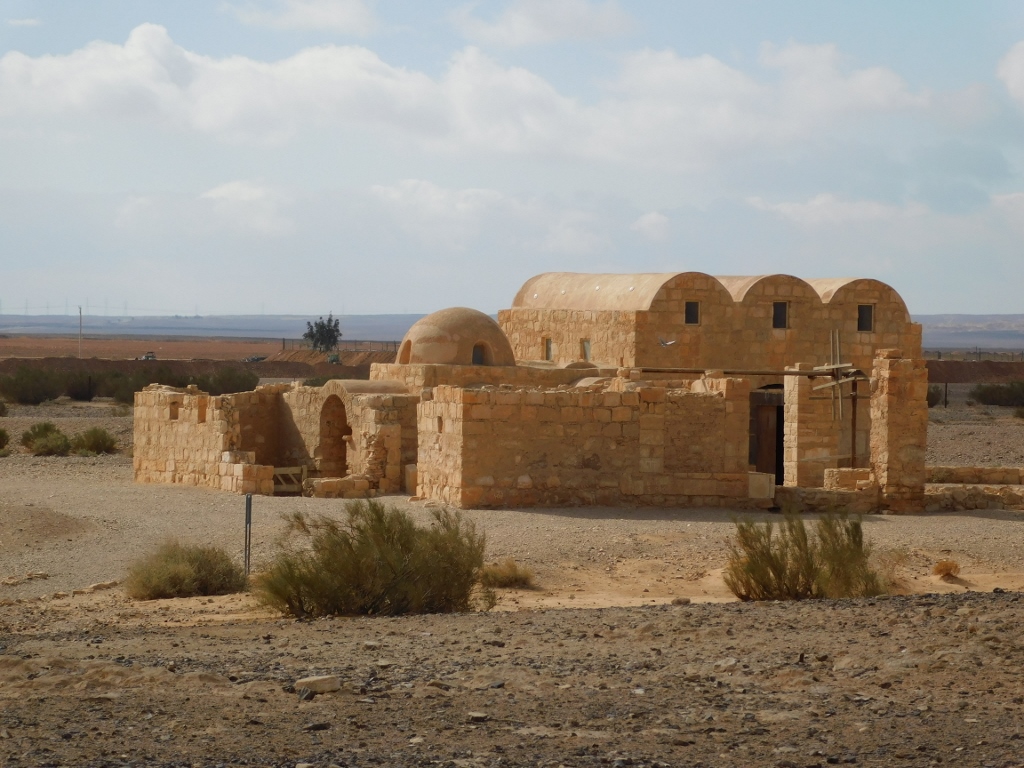 Quseir Amra
Quseir Amra
On my way to Azraq earlier this morning, I did make a stop here, but the site was closed at the time. Now it wasn’t and I could visit it nicely. The site was inscribed on the UNESCO’s World Heritage List already back in 1985. The reason for that is that this is the only place in the world where the frescoes from the Umayyad period have survived.
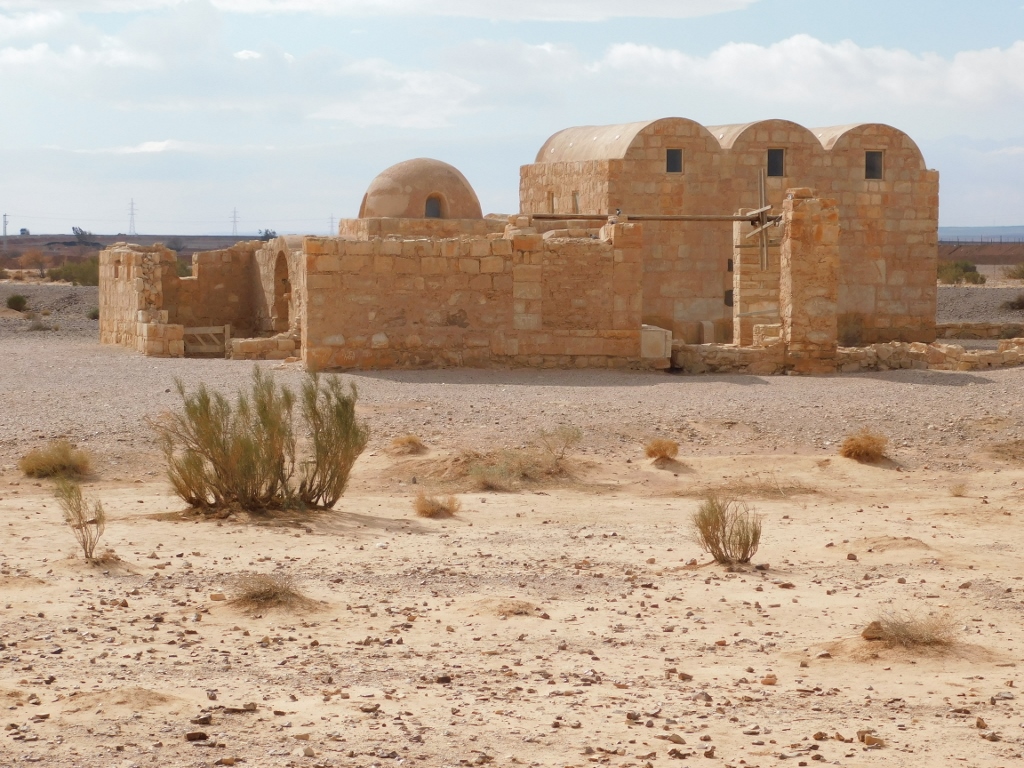 Quseir Amra
Quseir Amra
The structure was built in the first half of the 8th century and it served both as a small fortress with a garrison and as a residence of the Umayyad caliphs. The most important parts of this “castle” are the entrance reception hall and the hammam, i.e., the baths and this is precisely what managed to survive best from the Umayyad complex that originally existed here. On the basis of the excavations it has been established that the entire complex covered the area of 25 hectares.
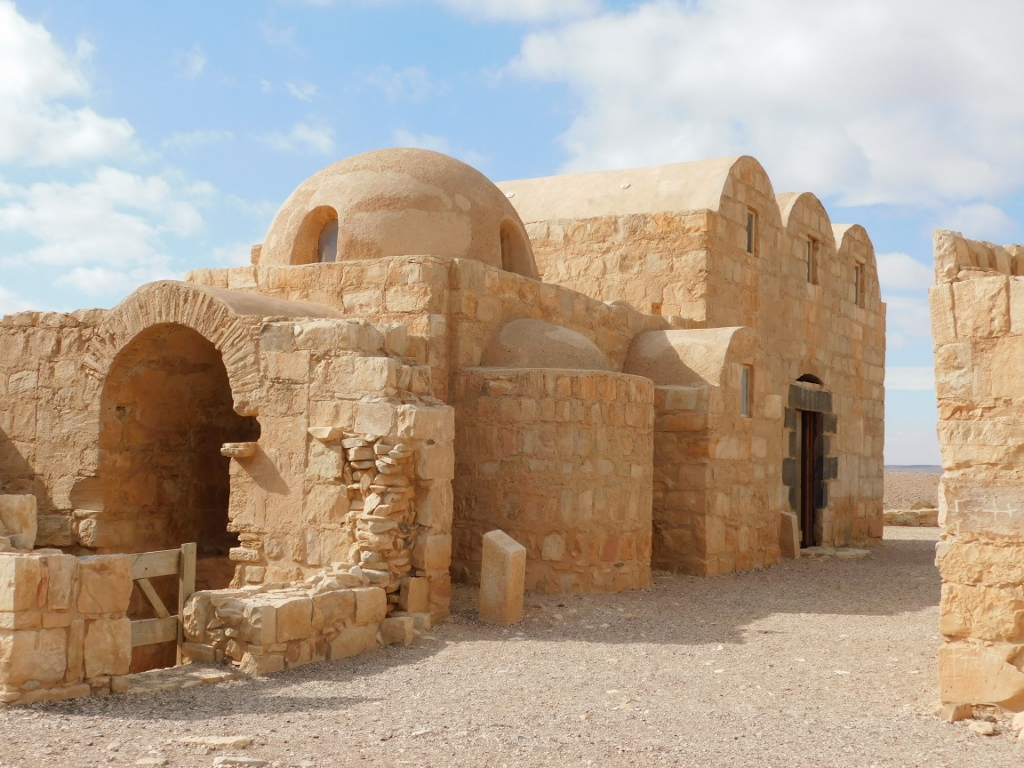 Quseir Amra
Quseir Amra
Although it seems quite odd in the middle of the desert (one should ignore for a moment that there is a motorway passing nearby), after all like other “desert castles,” this structure is very special primarily because of these frescoes that decorate its interior. Not only have these frescoes survived quite well over many centuries, but also they are dominated by figurative depictions which is exceptionally rare in Islamic arts. And not only are there figurative depictions, but there are also several depictions of nude women! I’ve said it well in the previous sequel of these travel stories: such places were used by caliphs to get some rest from the domestic disputes they must have been surrounded by back in Damascus that was the capital.
On approaching the structure, there is an information board noting that the building is very small and that visitors should be patient and wait for their turn to get in. The number of visitors of the interior space is limited to 20 persons. NONE of that is applicable in January! I was alone.
But, I was so impressed, already from the very doorway, that I forgot to take a photo of the whole space and only concentrated on taking photos of different segments of the frescoes. Luckily, I did do a video of the premises and here it is:
This entrance reception hall consists of three aisles, with thick arches in between. It is all exceptionally well painted. As I was alone and had the time, I took a photo of literally every fresco-composition, following exactly the description and the sequence I had in one of my guidebooks (in order to make it clearer what was what). Of course, I’m not going to post all of it here, because it is not that important for my travelogue after all, but I could not restrain myself and this is my “shortest” list:
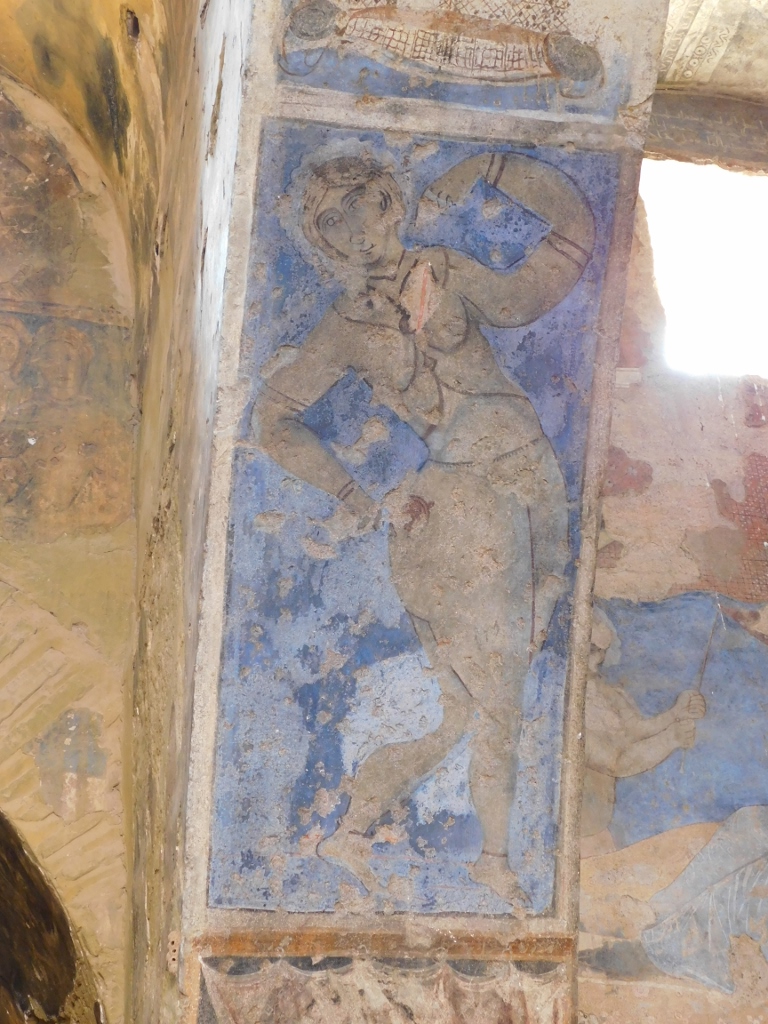 Nude female dancer welcoming visitors
Nude female dancer welcoming visitors
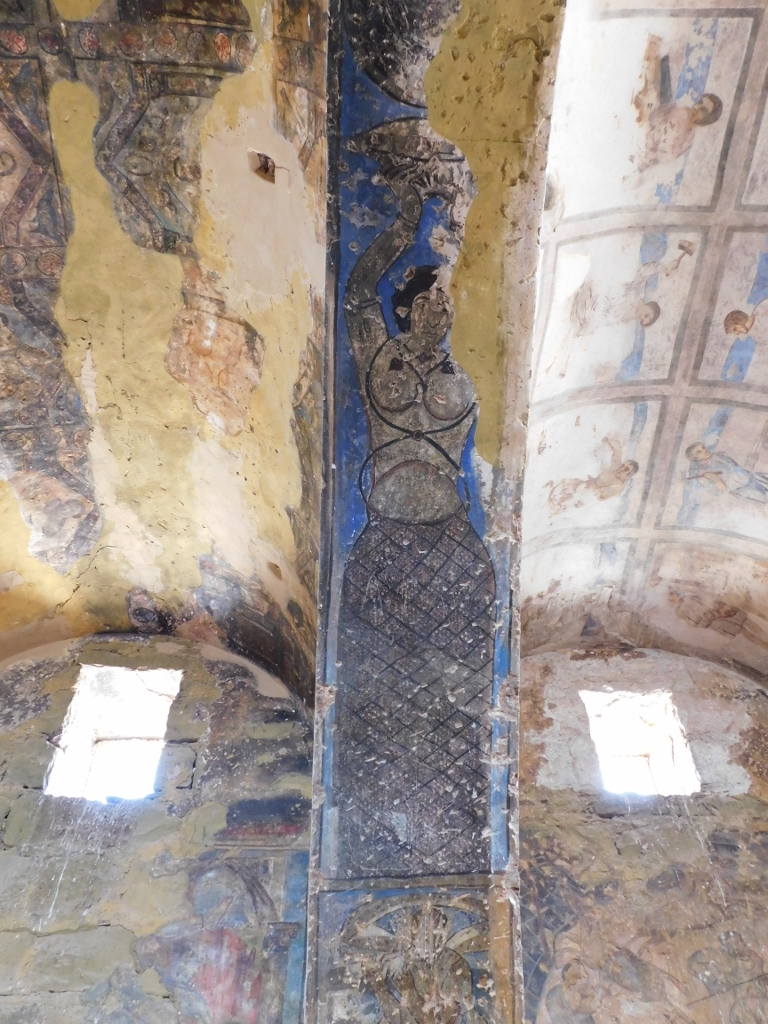 Another nude female on the arch between the middle (left) and the east aisles (right)
Another nude female on the arch between the middle (left) and the east aisles (right)
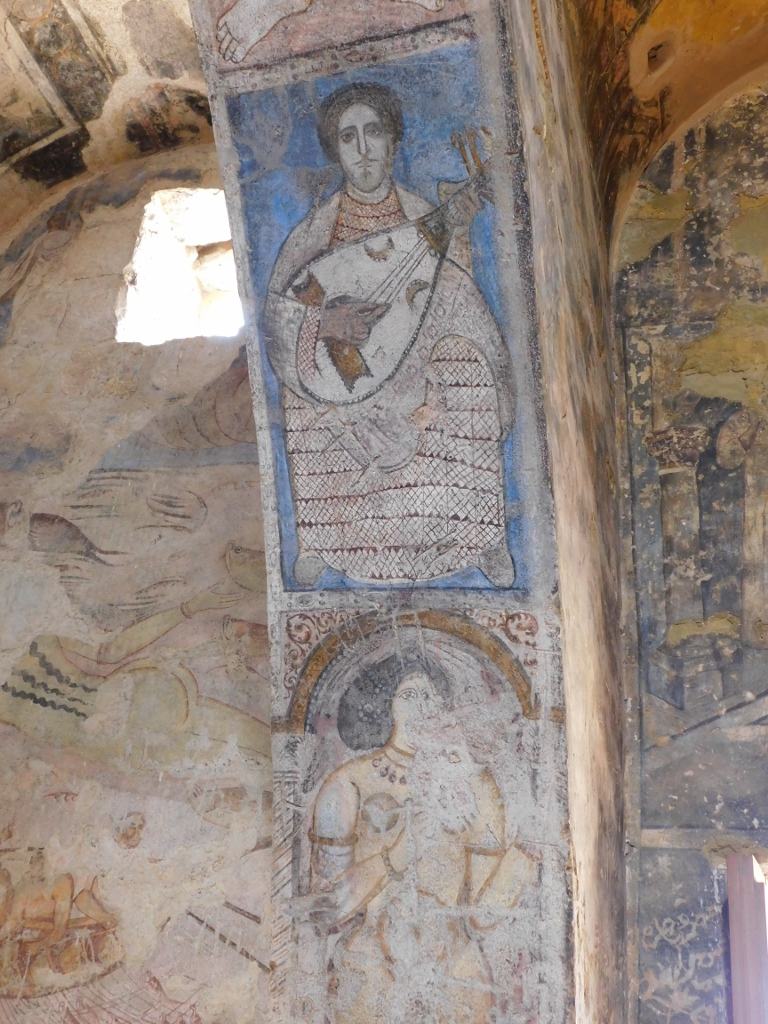 Lute player (above) and a nude flautist (below), on the arch between the west (left) and the middle aisles
Lute player (above) and a nude flautist (below), on the arch between the west (left) and the middle aisles
The composition on the south side of the west aisle shows Caliph Al Walid II resting on a couch under a baldachin. On the floor there is a woman and a man sitting as if waiting for an order by the caliph, while on the left-hand side there is a servant cooling the ruler by a peacock-feather fan. On the right-hand side of the fresco there is a man writing down something – probably what the caliph is dictating. Above the composition there are peacocks, while next to the right-hand one there is an inscription in Greek “NIKH,” meaning “victory.” However, this actually clearly shows the Byzantine influence on the early Islamic art.
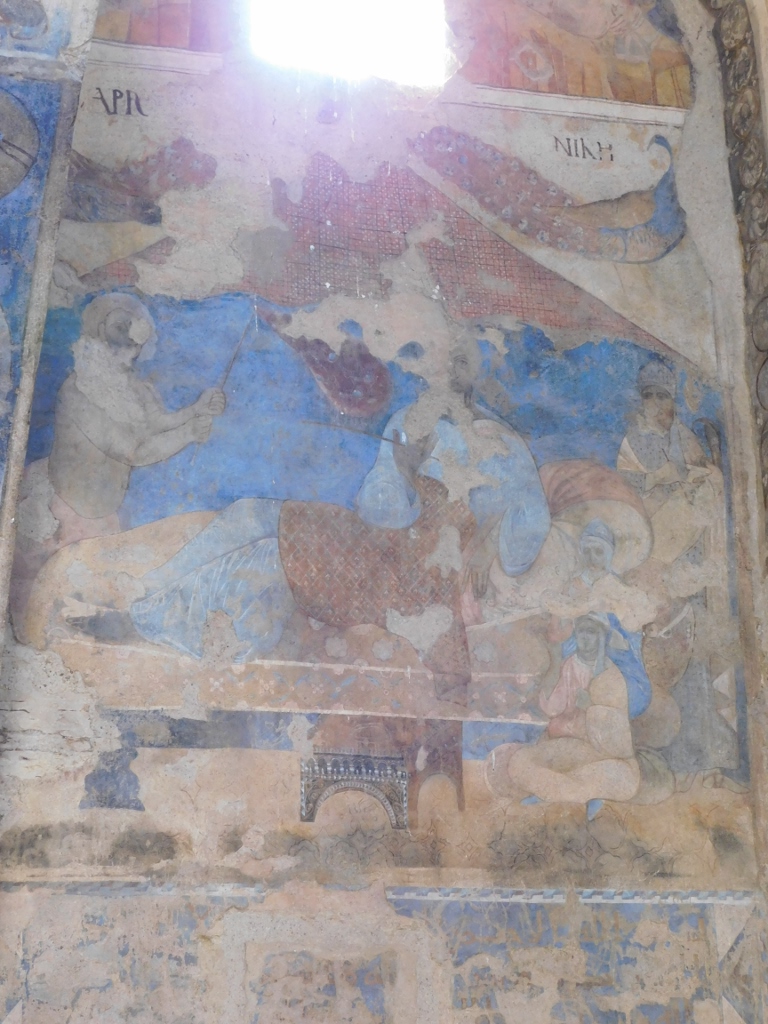 Quseir Amra, a detail
Quseir Amra, a detail
Right next to this composition, on the west wall, there is a famous fresco “Six Kings.” The six of them stand in two rows with three figures in each. On the basis of the Greek and Arabic inscriptions above four of them, their identities have been ascertained. The fresco is rather damaged mostly “thanks” to the attempt of the first Westerner who came here in 1898 and tried to get the fresco off the wall and take it OUTSIDE the country it used to belong to (at the time it was the Ottoman Empire). Some fragments have ended up at the Museum of Islamic Art in Berlin.
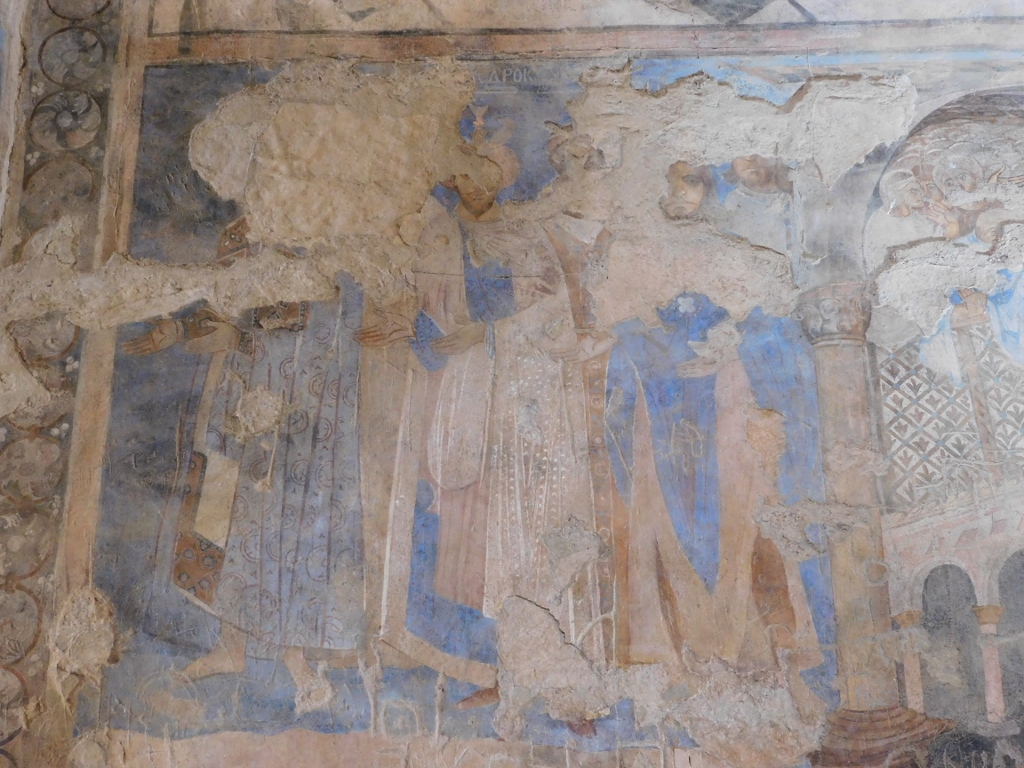 Quseir Amra, Six Kings fresco
Quseir Amra, Six Kings fresco
The next composition on the west wall shows a nude female bather who does not care at all that a bunch of people are looking at her (to the left on the photo). She is just having a bath.
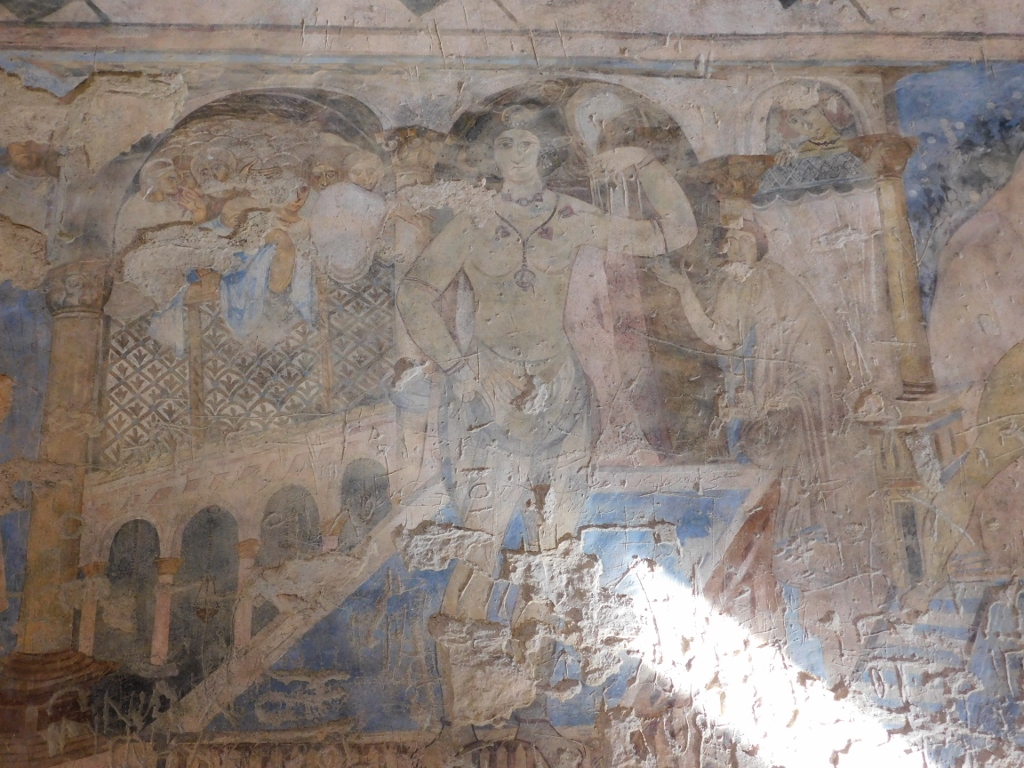 Quseir Amra, a detail
Quseir Amra, a detail
When you look at the entire west wall, you can see these two compositions I have just mentioned, as well as a scene with young gymnasts (in continuation). Above them, there is a scene in which wild asses with pricked ears are chased into nets.
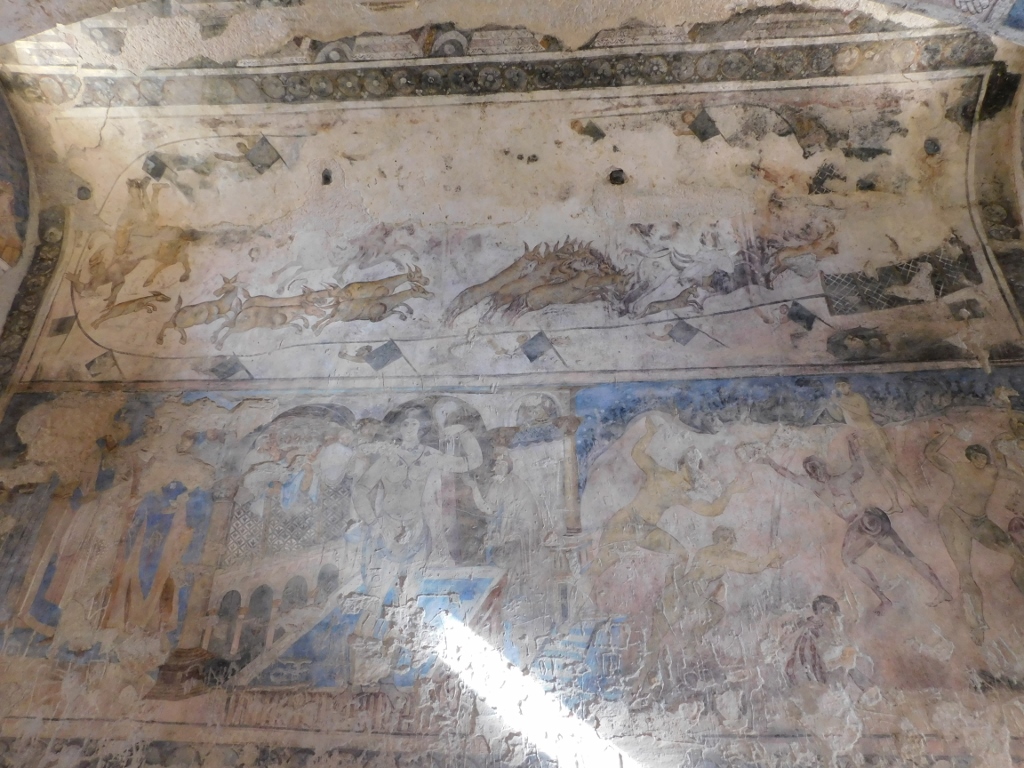 Quseir Amra, west wall of the west aisle
Quseir Amra, west wall of the west aisle
In the back of the middle aisle, there is a Throne Apse. Its lateral walls are decorated on both sides with depictions of leopards, fruit trees and different human figures, while on the south wall, straight from the entrance, there is a ruler sitting on a throne and being fanned from both sides by servants (or perhaps they are whisking flies away), while around the scene there is a partridges frieze.
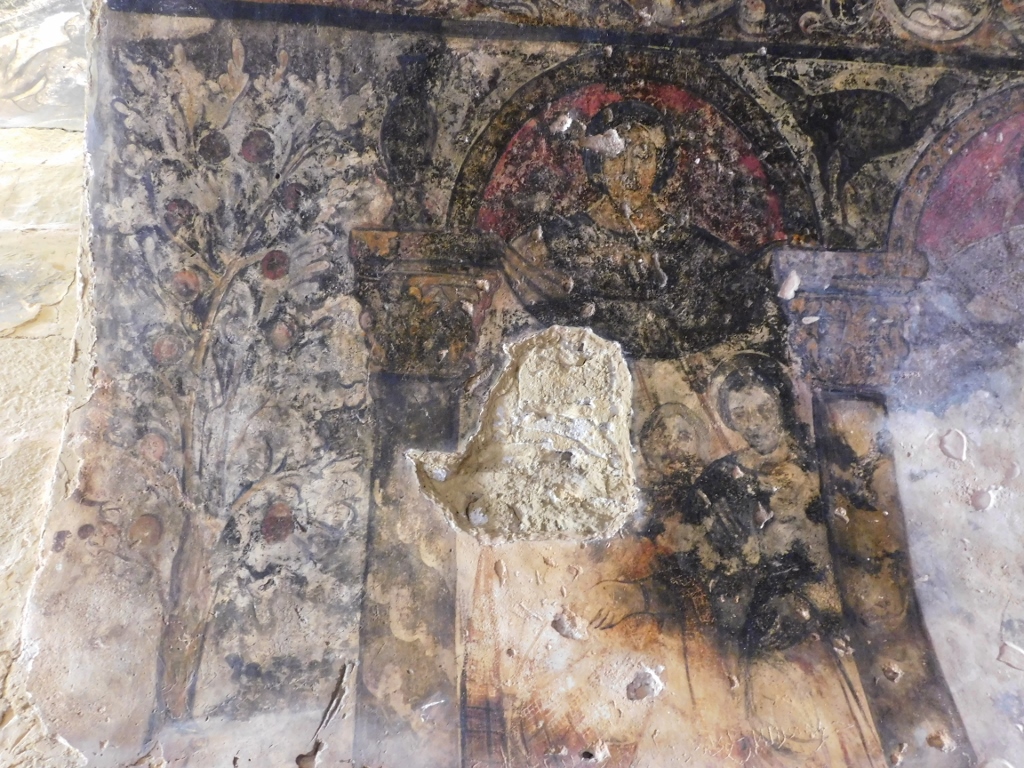 Quseir Amra, Throne Apse, a detail
Quseir Amra, Throne Apse, a detail
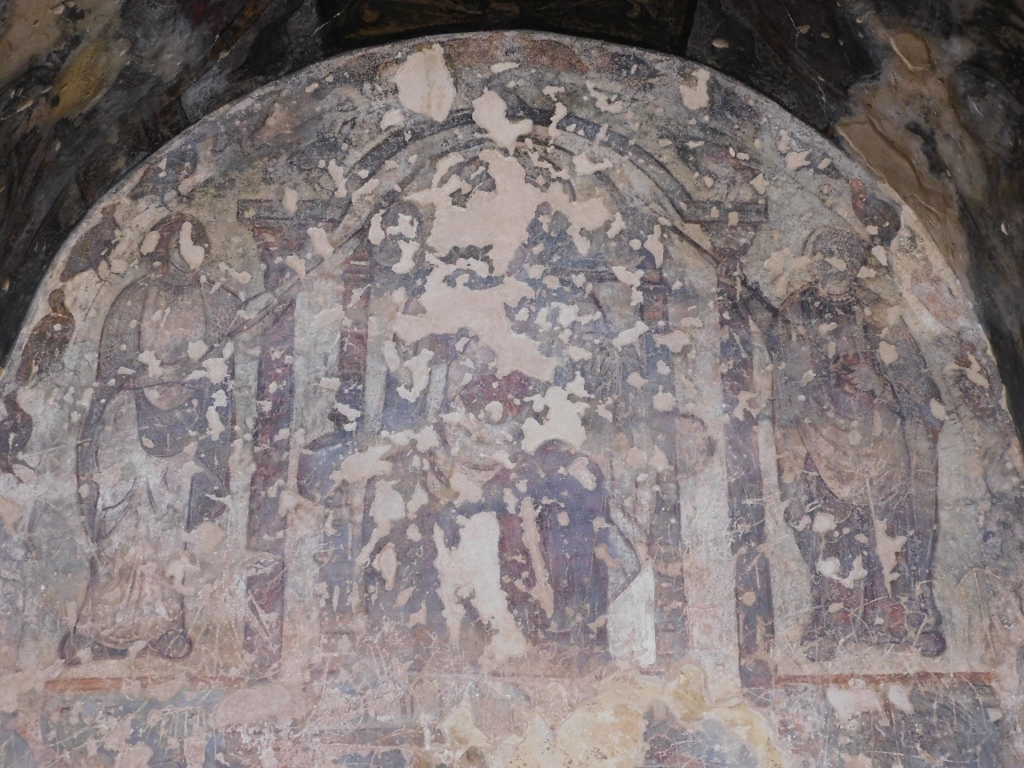 Quseir Amra, Throne Apse, a detail
Quseir Amra, Throne Apse, a detail
On both sides of the Throne Apse there are rooms entered through open doorways, but the passage there was prevented by an installed fence. Also, these rooms do not have sufficient light, so I had to bend a lot in an attempt to take a photo or two. The important elements are the floor mosaic, as well as the depictions of fruits on the walls.
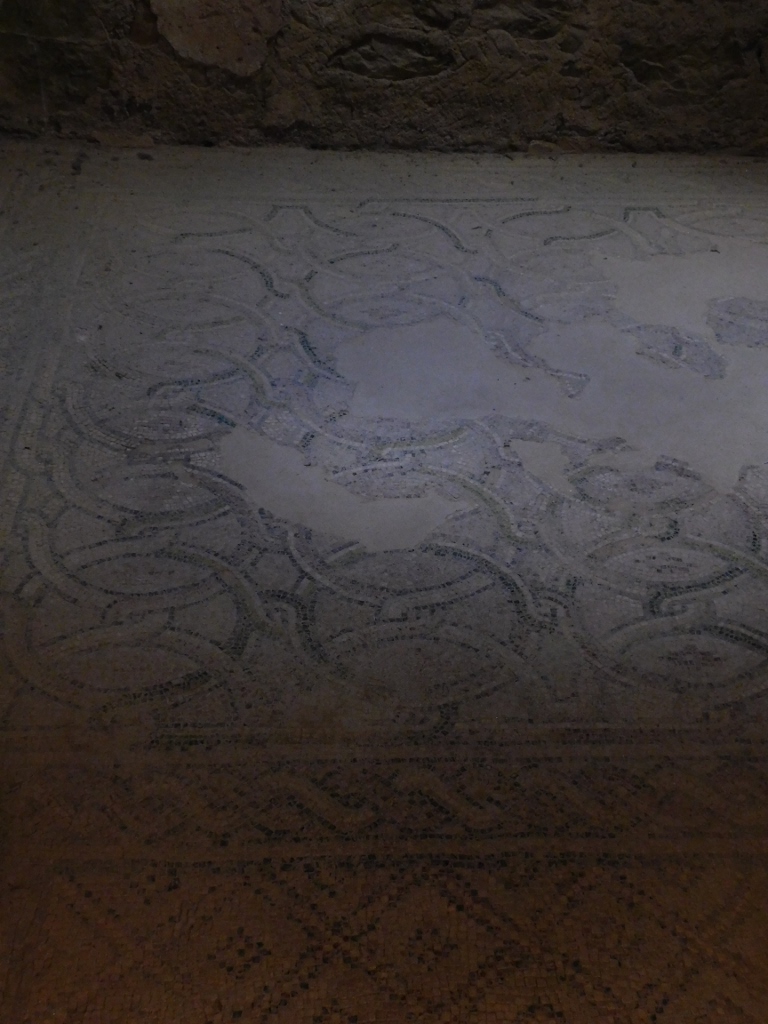 Quseir Amra, a detail of a room adjacent to the Throne Apse
Quseir Amra, a detail of a room adjacent to the Throne Apse
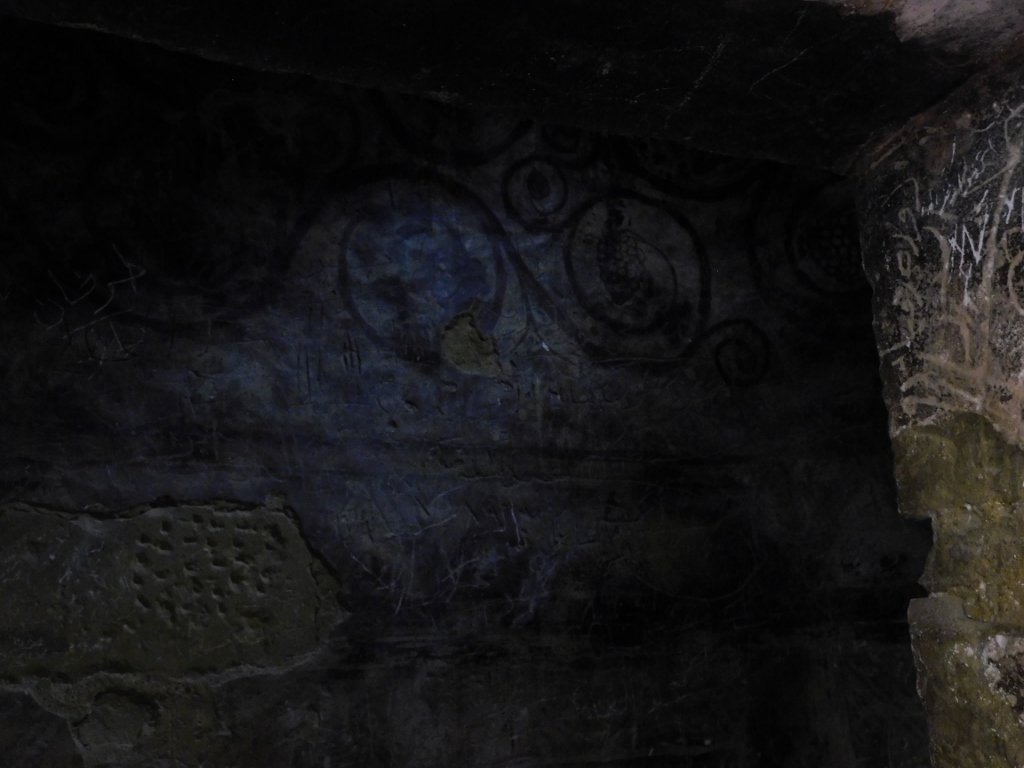 Quseir Amra, a detail of a room adjacent to the Throne Apse
Quseir Amra, a detail of a room adjacent to the Throne Apse
The east aisle is dedicated more to the images of hunt. On the north wall you can see again wild asses being chased into nets, but there is also a butchering scene at the bottom of the fresco.
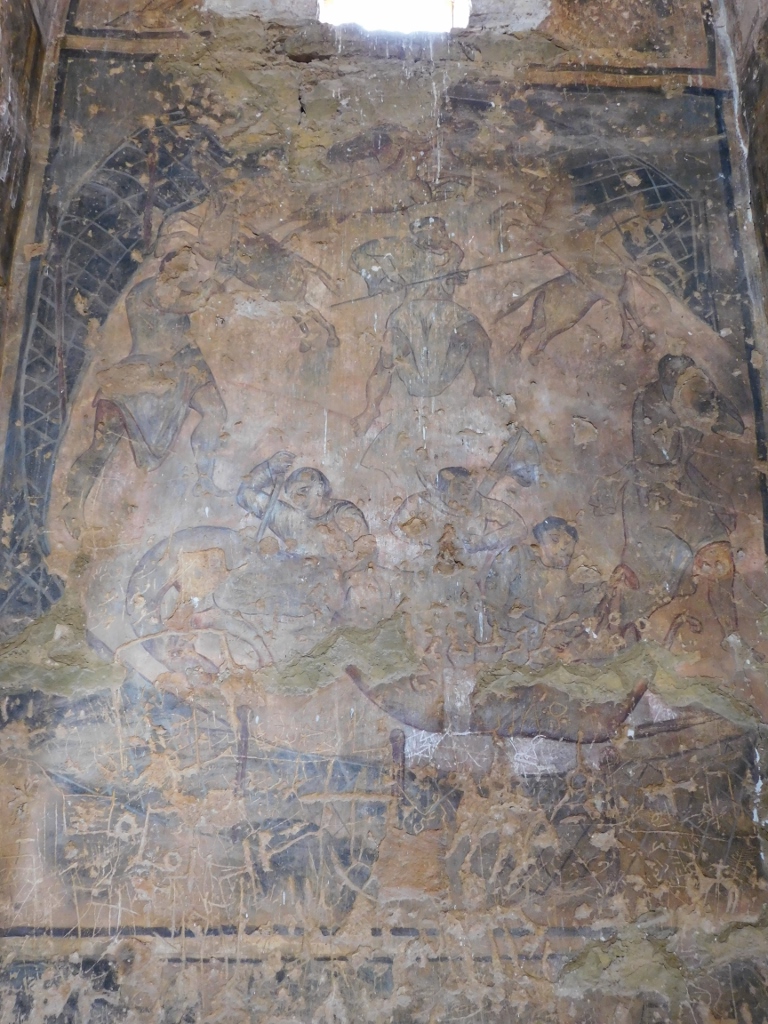 Quseir Amra, wild ass hunt
Quseir Amra, wild ass hunt
The east wall also exhibits depictions of Persian greyhounds, aka Saluki, used intensively in the hunt.
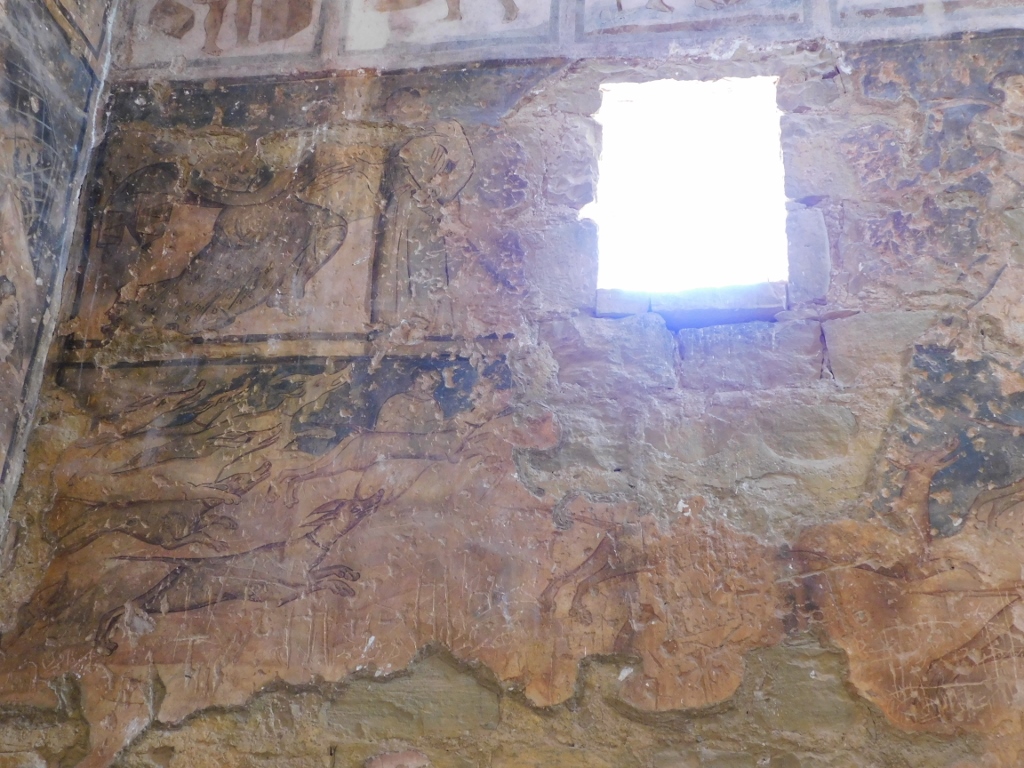 Quseir Amra, hunting Persian greyhounds (bottom left)
Quseir Amra, hunting Persian greyhounds (bottom left)
On the south wall of the east aisle, there is another hunting scene, but although my guidebook mentioned only wild asses, judging by the horns clearly seen on the caught animals, I would rather say that these are in fact Arabian oryxes.
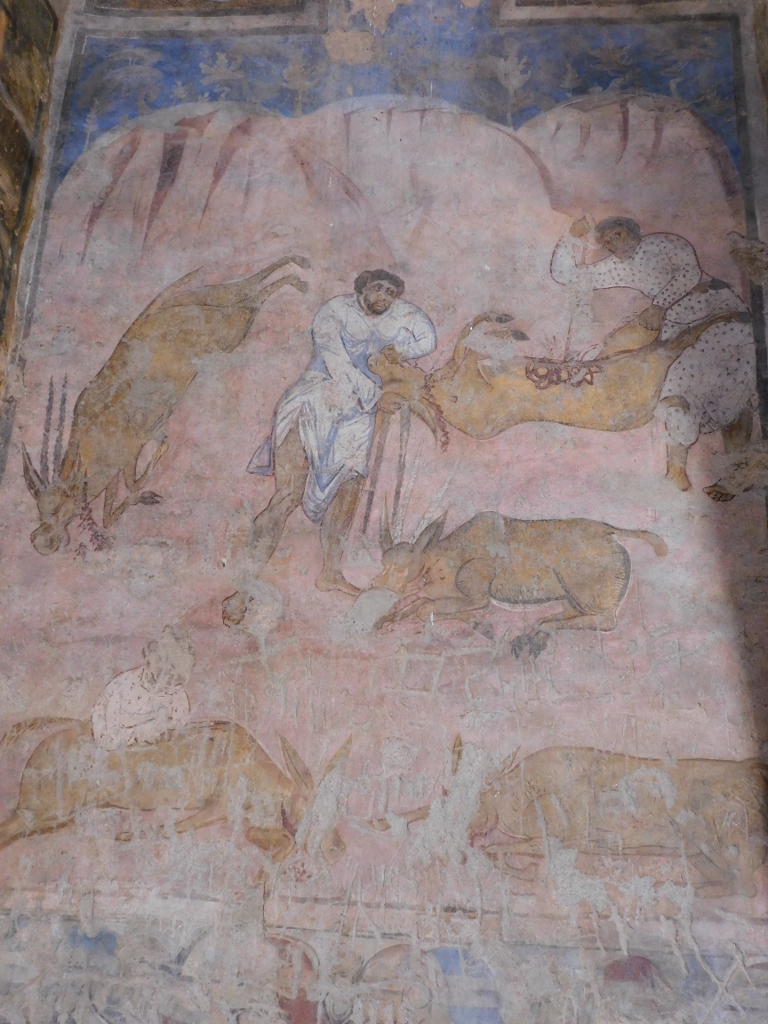 Quseir Amra, Butchering of Arabian oryxes
Quseir Amra, Butchering of Arabian oryxes
By the way, let me mention that the Arabian oryx was officially extinct in the wild in 1972 and at the time it was bred only in zoos, but its gradual reintroduction in the wild has started already since 1980.
Above this scene with Arabian oryxes, on both sides of a window that exists here, there are depictions of the muses of history and philosophy, as well as that of the muse of poetry.
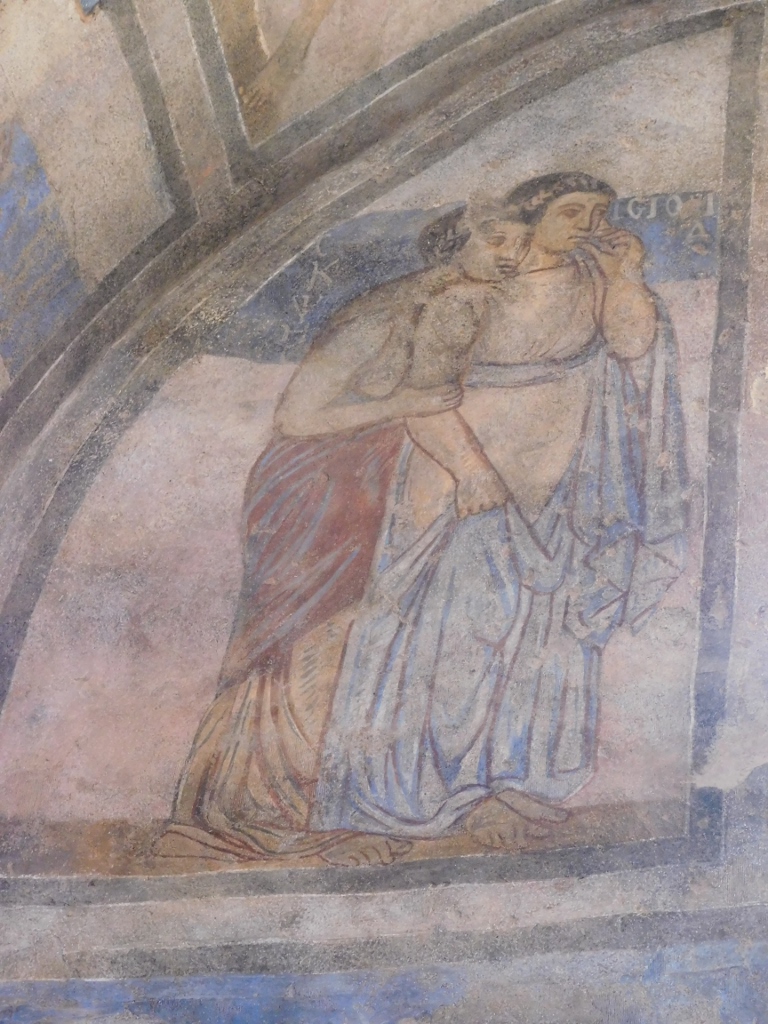 Quseir Amra, philosophy and history muses
Quseir Amra, philosophy and history muses
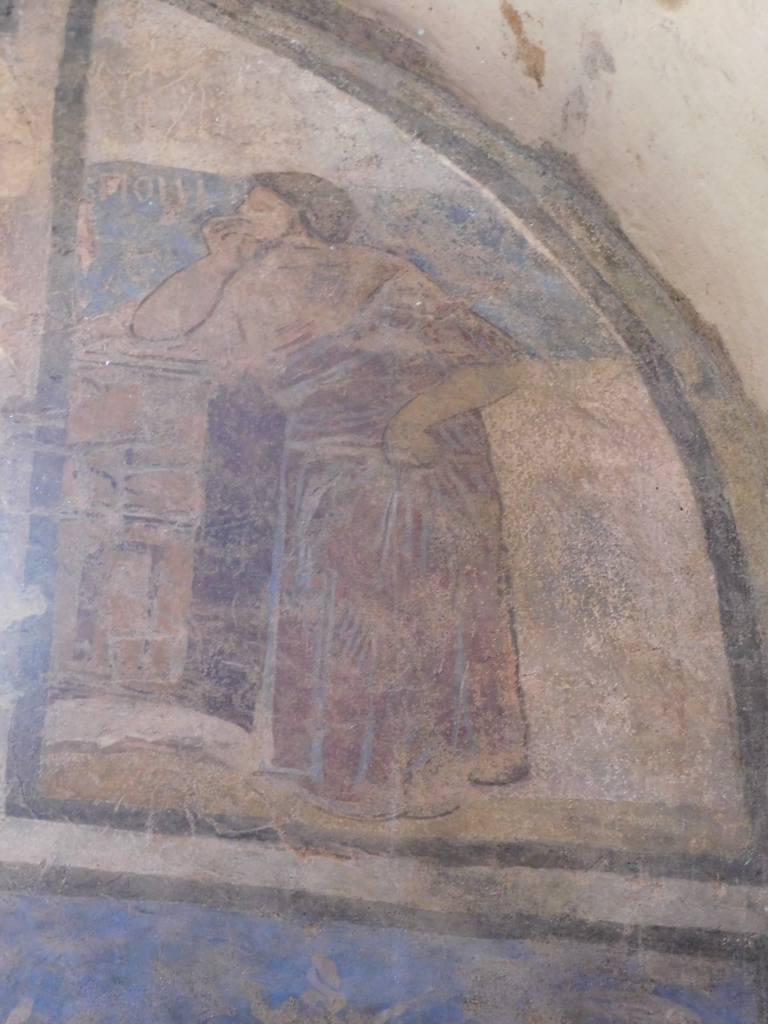 Quseir Amra, poetry muse
Quseir Amra, poetry muse
But, the frescoes in the barrel-vault of the east aisle are also very interesting because they show craftsmen and camels.
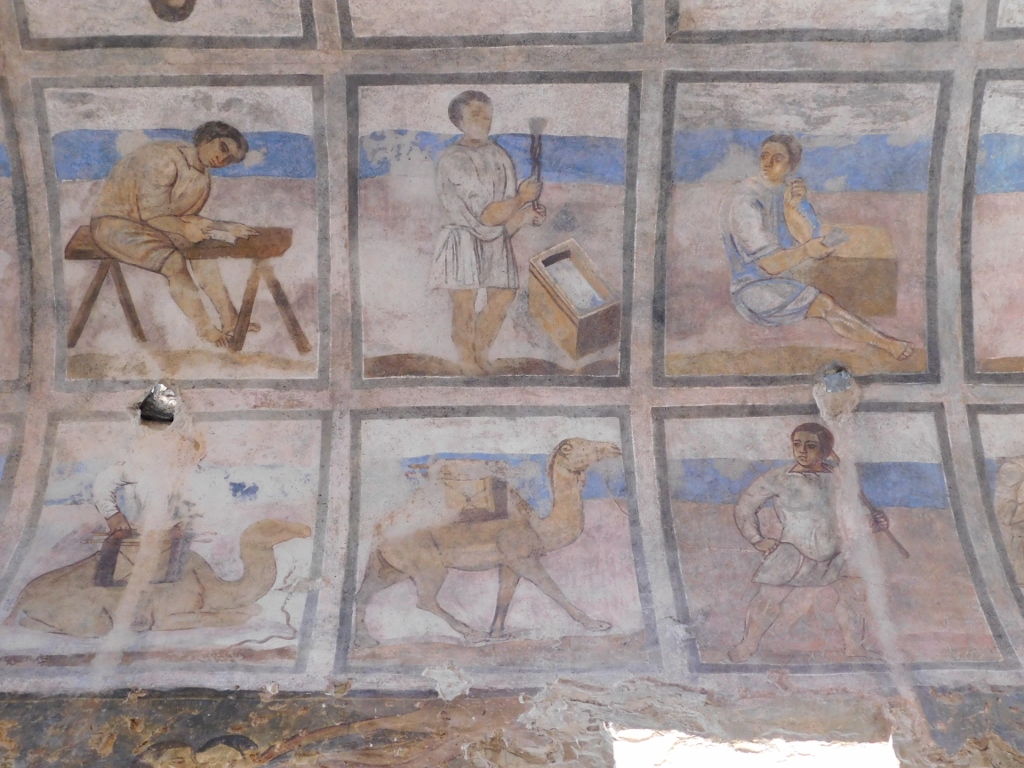 Quseir Amra, frescoes on the ceiling of the east aisle
Quseir Amra, frescoes on the ceiling of the east aisle
From the east aisle one enters the section that was used as the baths. The first room there is the one that archaeologists believe to have been a changing room or the apodyterium. Here, too, there are some interesting frescoes. Right above the entrance there is a composition that shows a reclining woman who is watched by an admirer, while there is also a cupid getting ready to introduce the necessary dynamics.
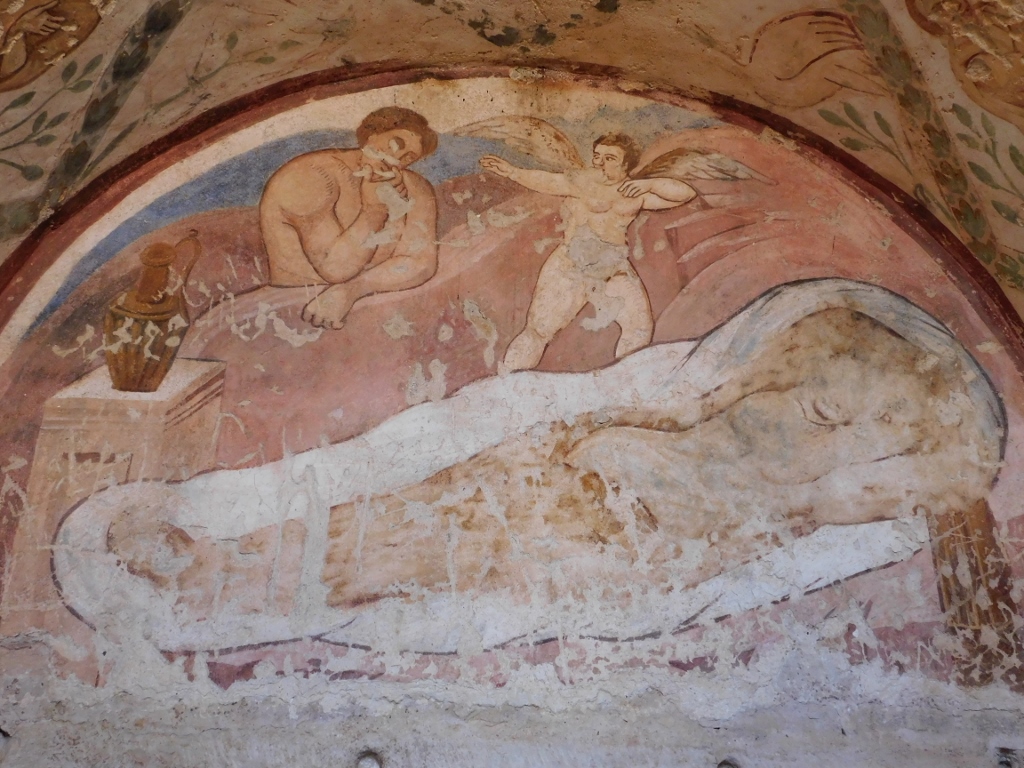 Quseir Amra, a fresco in the changing room
Quseir Amra, a fresco in the changing room
The longitudinal walls of the barrel-vault are divided into rhombuses and each field contains some depiction, mostly of animals, but some of them are in unexpected roles. Thus, for instance, there is a bear playing lute, while a monkey is giving him applause from the adjacent field.
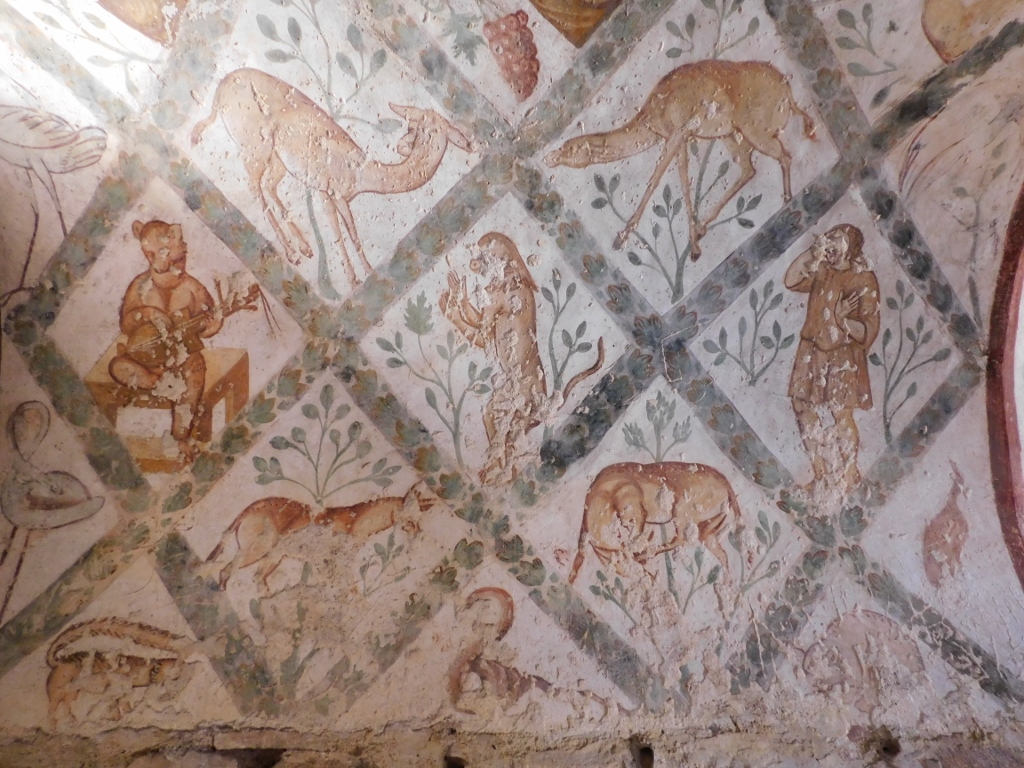 Quseir Amra, a fresco in the changing room
Quseir Amra, a fresco in the changing room
Particularly interesting is the top of the barrel vault in which you can see three male portraits that depict three phases of life. I especially liked the portrait of the elderly man because of the exceptionally expressive eyes.
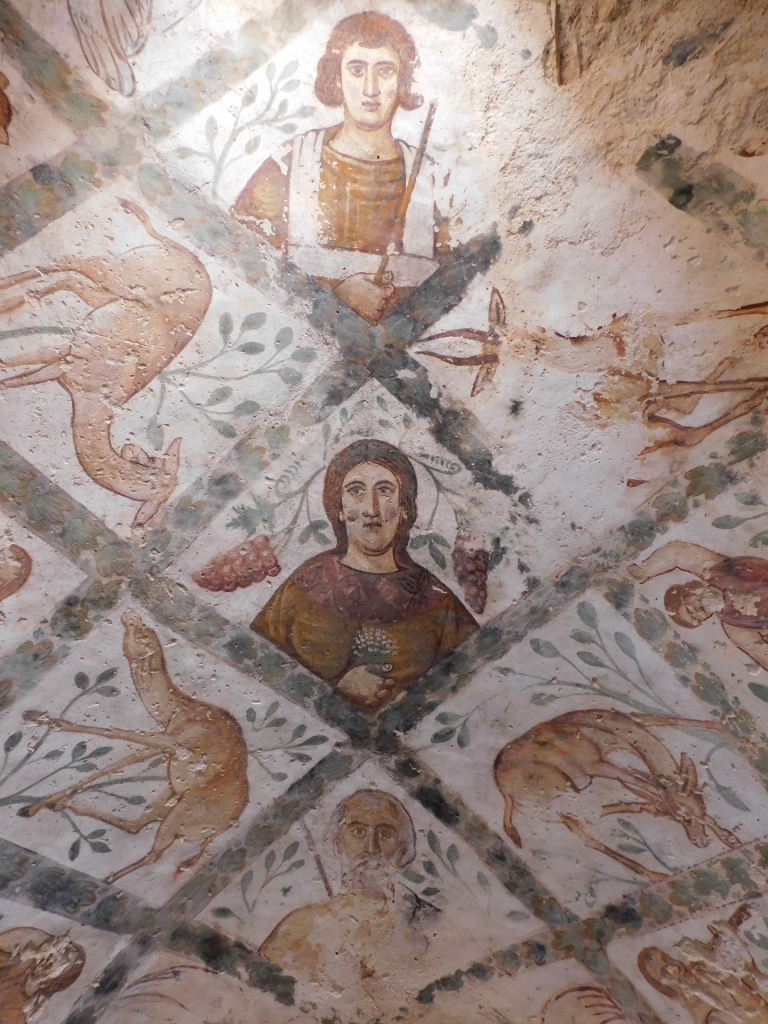 Quseir Amra, a fresco in the changing room
Quseir Amra, a fresco in the changing room
The next room was the warm bath or the tepidarium. To start with, you can see remains of the hypocaust. This is a system of floor heating. Fire is made in a hearth and then the hot air goes between small pillars made of bricks over which there is the floor of the room that is being heated in this way. The hot air often also goes along vertical flues that exist in the walls.
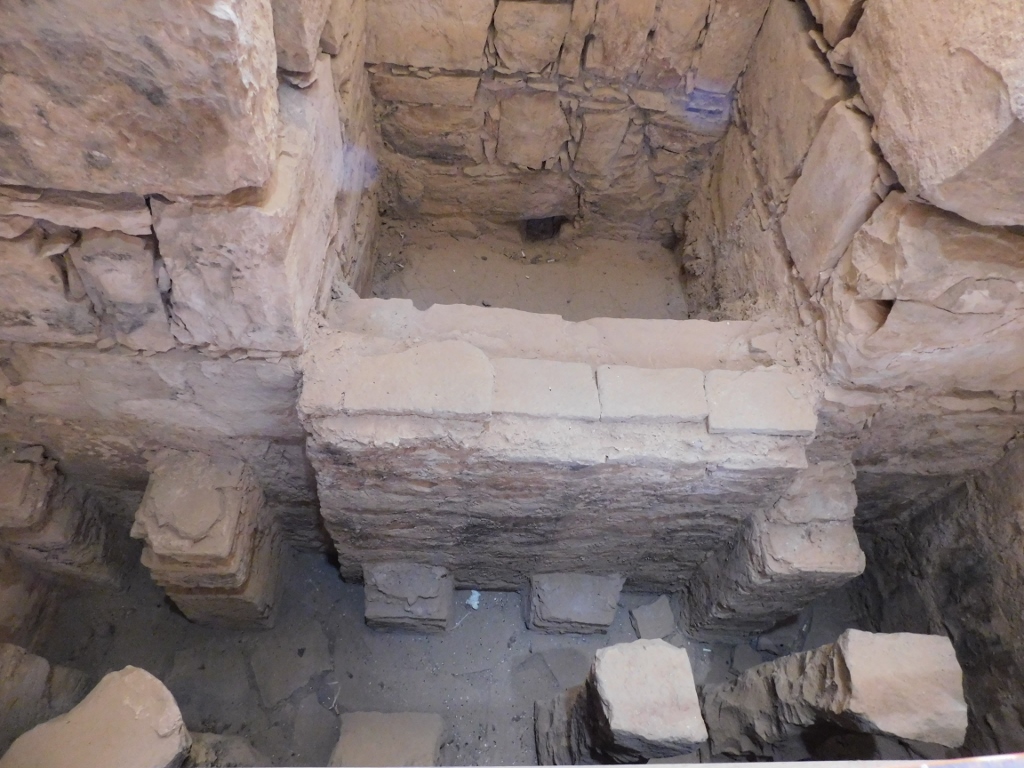 Quseir Amra, remains of the hypocaust in the tepidarium
Quseir Amra, remains of the hypocaust in the tepidarium
The frescoes here are again very interesting, although it is quite clear that they were made by another artist in comparison to those from the main hall.
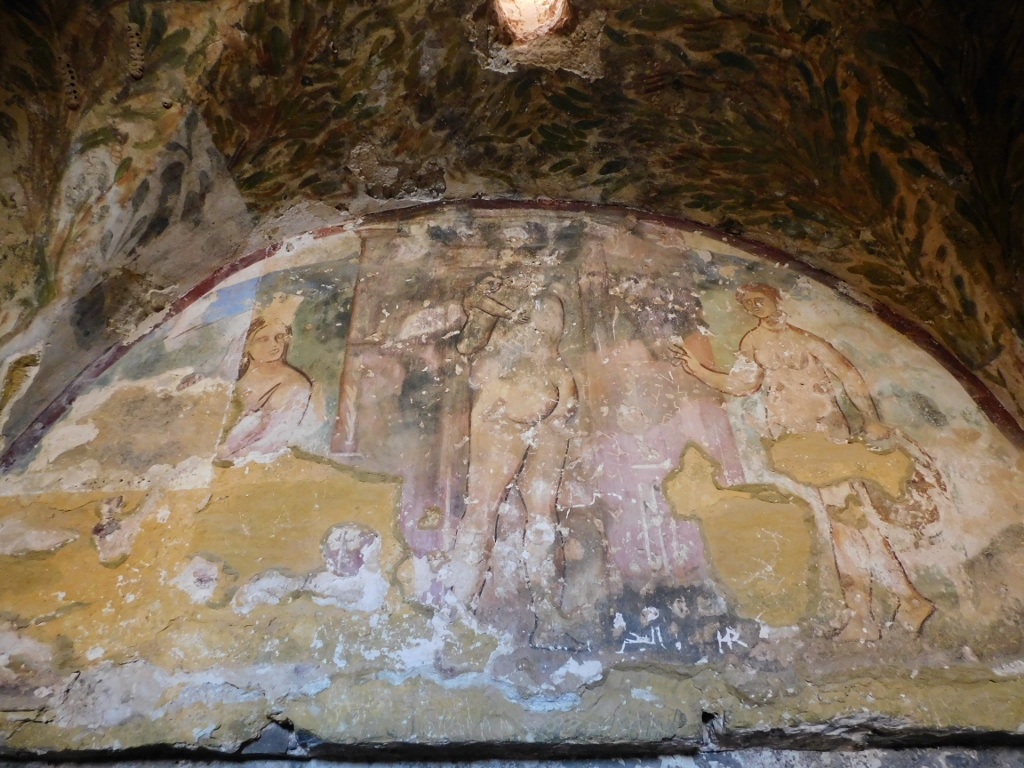 Quseir Amra, a tepidarium fresco: a woman holding a baby in her arms
Quseir Amra, a tepidarium fresco: a woman holding a baby in her arms
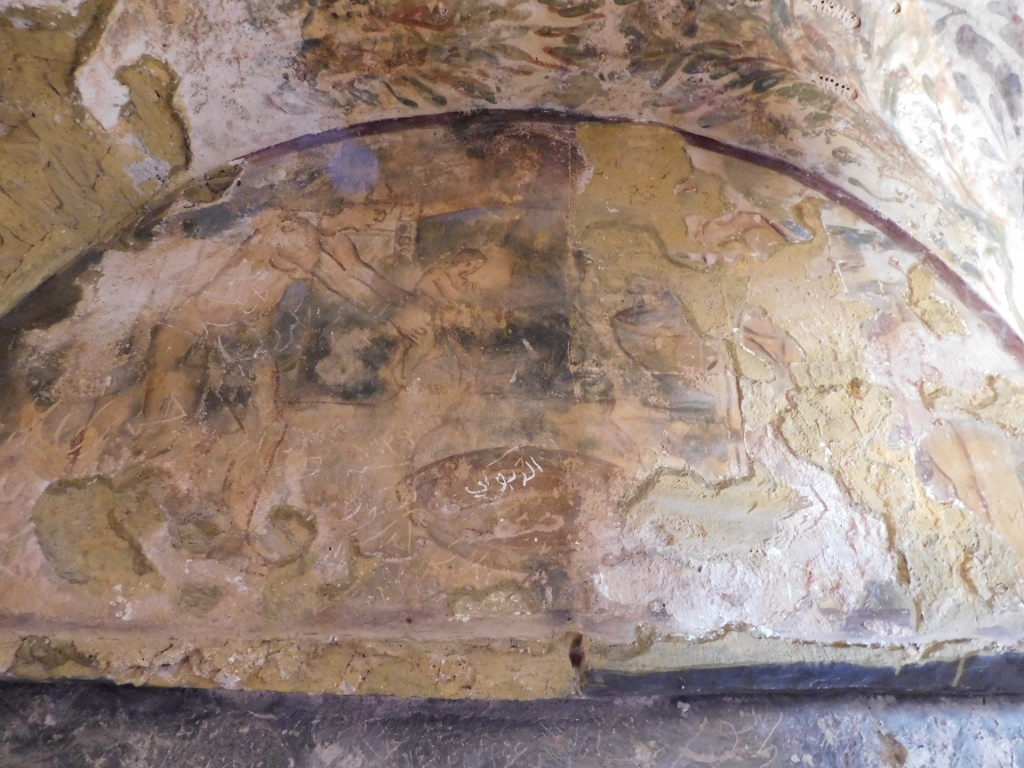 Quseir Amra, a tepidarium fresco: a woman about to bathe a baby
Quseir Amra, a tepidarium fresco: a woman about to bathe a baby
The next and the last room in the sequence is the hot bath or the caldarium. Here, too, you can see remains of the hypocaust, but the most important element in this room is the dome above it. It contains paintings of the night sky with the depictions of the Zodiac. This is also the oldest depiction of the Zodiac on a spherical surface.
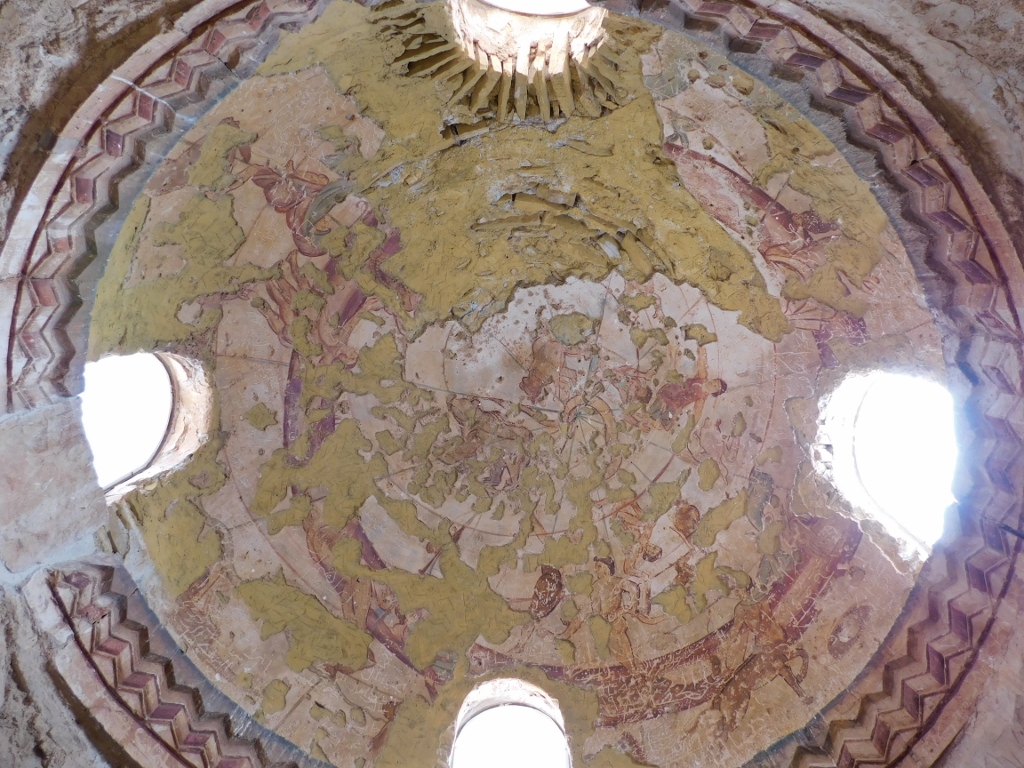 Quseir Amra, the caldarium dome: the night sky
Quseir Amra, the caldarium dome: the night sky
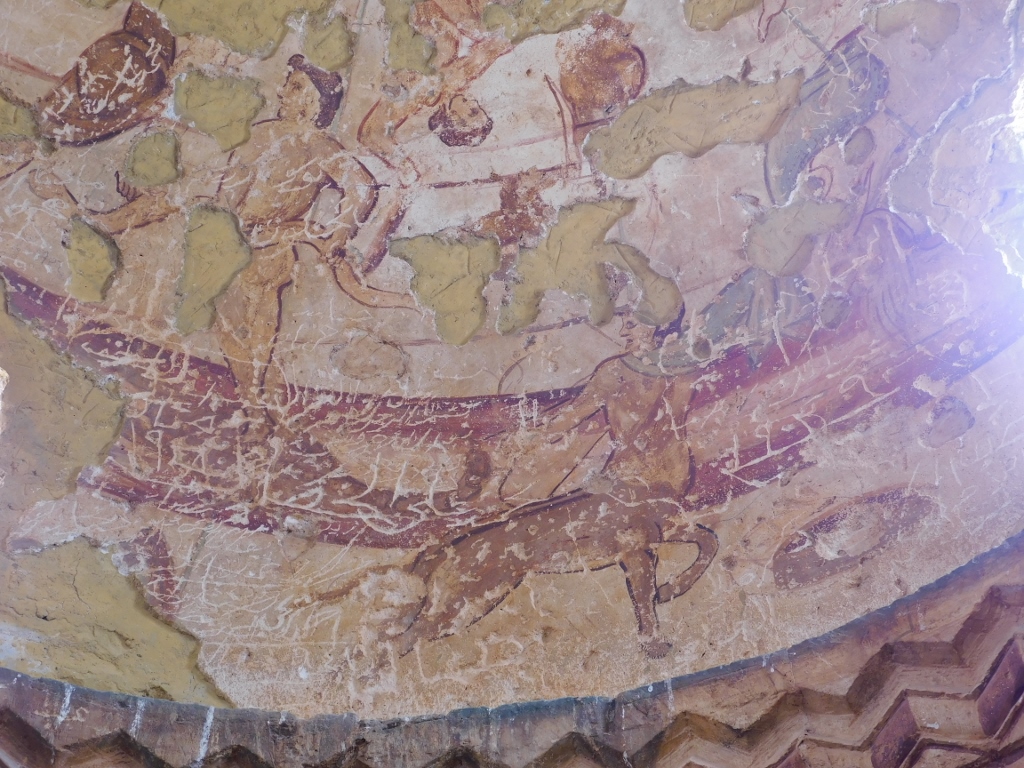 Quseir Amra, depiction of Sagittarius is clearly seen
Quseir Amra, depiction of Sagittarius is clearly seen
I finished with my visit to Quseir Amra here, so I just turned around and walked back the same way I came. Soon I was out where right opposite the entrance there is a structure that in fact made it possible to have this “spa centre” in the middle of the desert – a well some 40 metres deep, an animal-driven system for the pumping of water and a cistern.
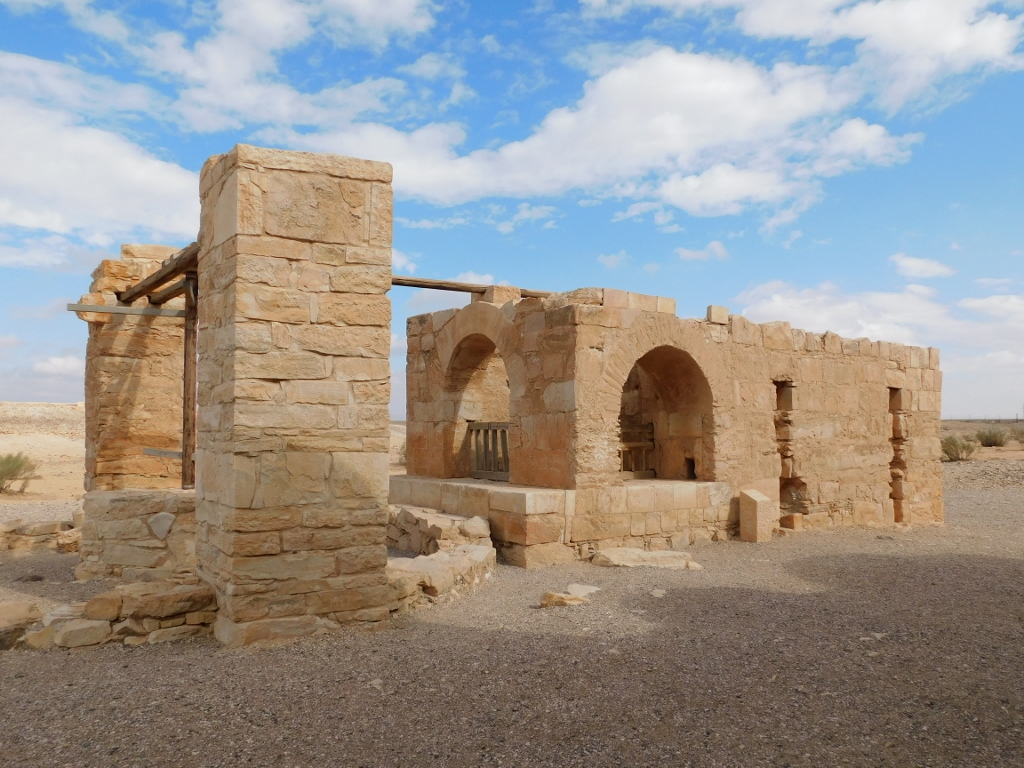 Quseir Amra, the water-supply system
Quseir Amra, the water-supply system
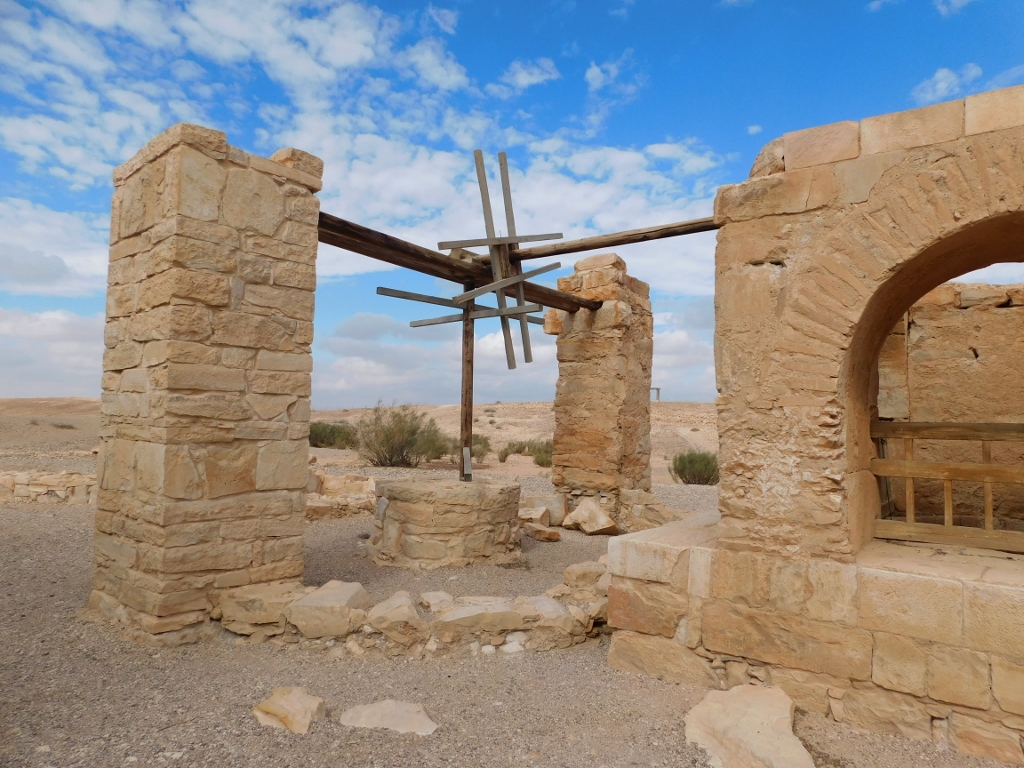 Quseir Amra, the water-supply system
Quseir Amra, the water-supply system
Then I walked around the main building, looking at it from the outside as well.
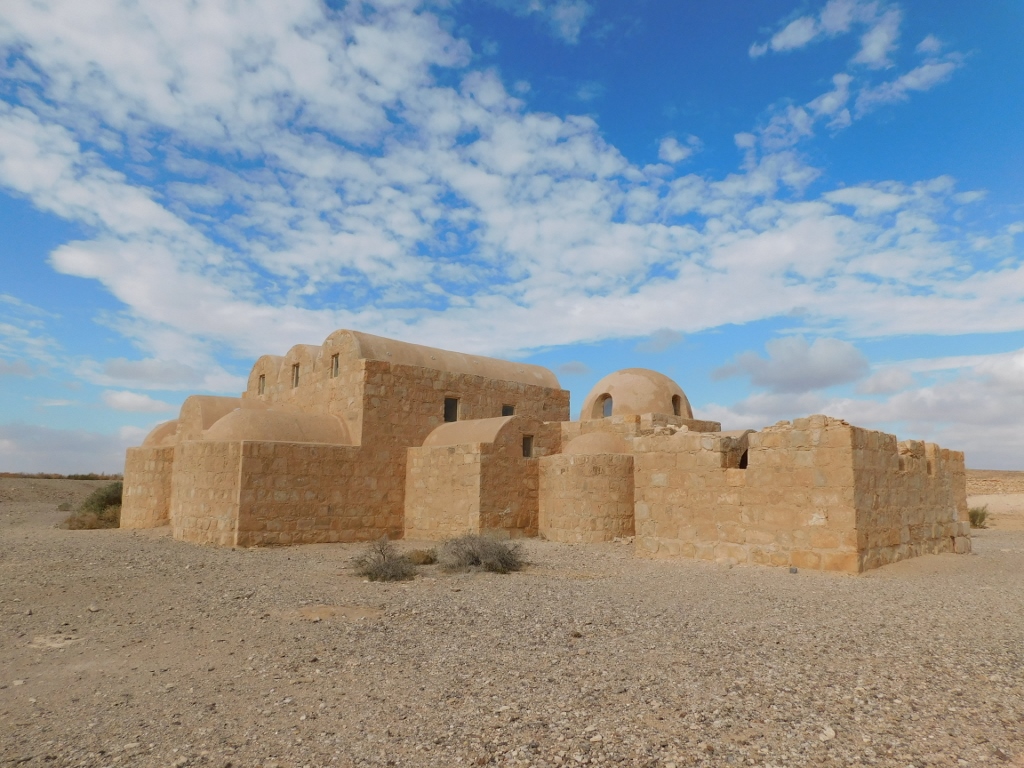 Quseir Amra
Quseir Amra
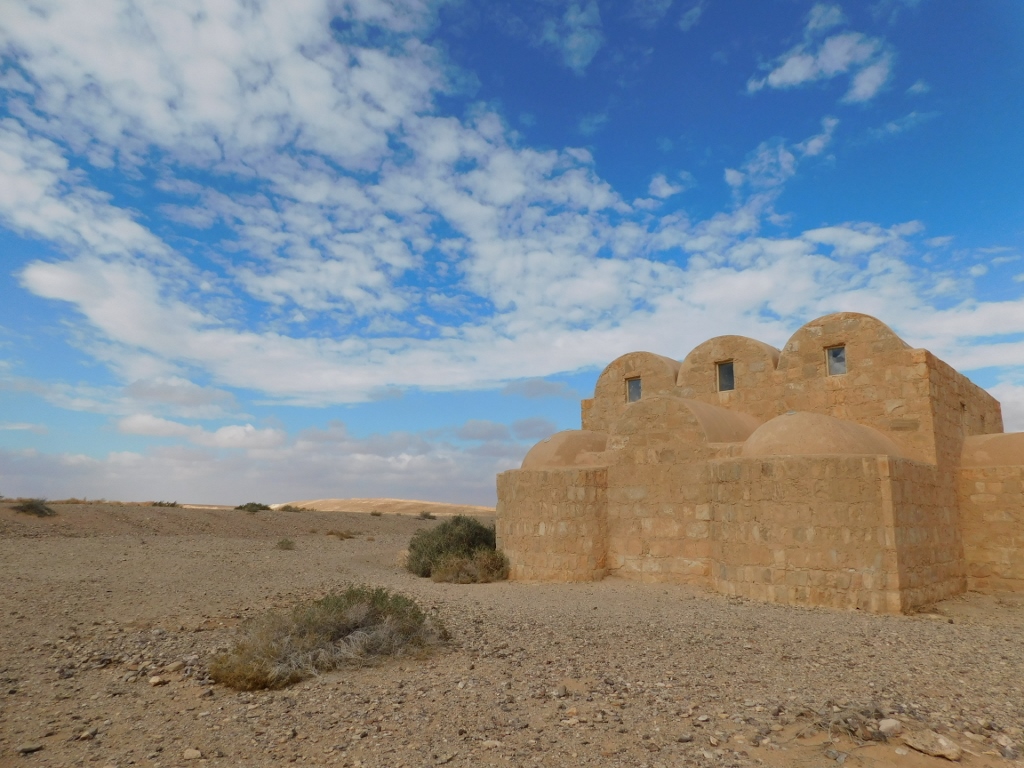 Quseir Amra
Quseir Amra
After this I followed the visitor path that goes a little around and up to a slight elevation from where I had an excellent view in all directions. It seems completely incredible that such a magical place is located in the middle of the desert, regardless of the fact that nowadays here and there you can see details of the modern world.
 Quseir Amra
Quseir Amra
 Quseir Amra
Quseir Amra
 Quseir Amra
Quseir Amra
When I finished with my visit to Quseir Amra, I continued with the rest of the excursion for the day. Again I was taken along the motorway past the “desert castle” of Qasr Kharana, but I did not feel like making a stop. I thought I had seen all I was really interested in. Instead, I headed for yet another “desert castle” – Qasr Al-Mushatta.
This castle is situated in some kind of an industrial zone, very close to the international airport in Amman, some 30 km south from the centre of the Jordanian capital. The driver that brought me here decided to follow some shortcuts, which was actually quite interesting; much more than if we had followed the main roads. We drove past agricultural fields that were getting ready for the sowing. I asked the driver what they cultivated there and he said – barley.
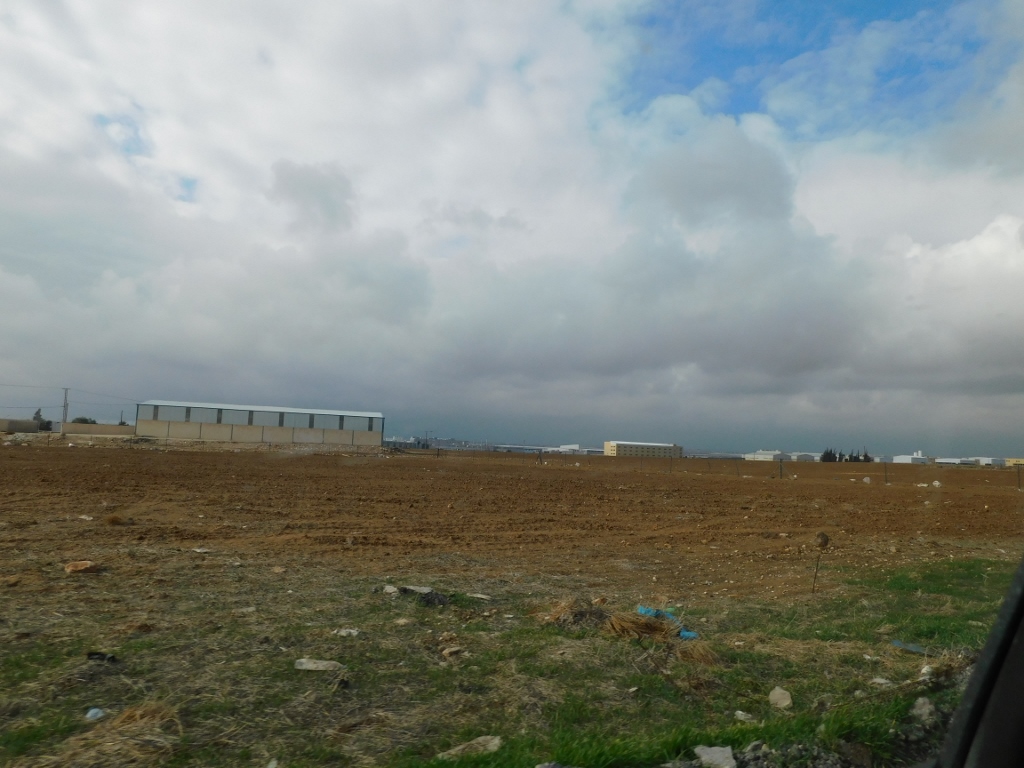 Fields and industrial plants near Amman
Fields and industrial plants near Amman
I must admit I was surprised by, as it seemed to me, large areas of agricultural land, but the desert is never too far away here.
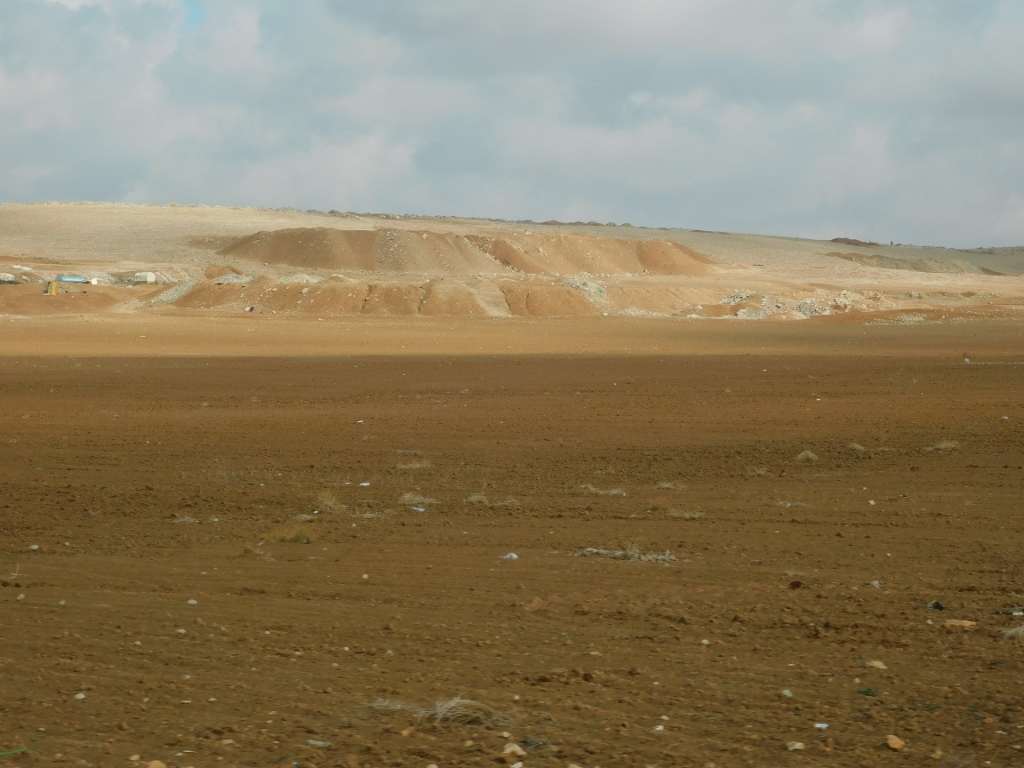 Some arable land and some desert
Some arable land and some desert
And then we got to the site of Qasr Al-Mushatta. There was nobody selling tickets here because it seemed that the site was still not fully prepared for visitors. In addition, the driver told me that he had never brought anybody here and he had actually never heard of this site before, but he was using the internet navigation.
 Qasr Al-Mushatta
Qasr Al-Mushatta
These are remains of the biggest and the most ambitious palace which the Umayyad caliphs built on the territory of the present-day Jordan. It is presumed that this “desert castle” was first constructed around 740 CE, but it was never completed, since the Umayyad dynasty was overthrown already in 750. The palace is surrounded by enclosure wall in the shape of a square and each side is 144 m long, while there are also 25 semi-circular towers. The palace is particularly interesting because of the use of reddish fired bricks in its construction.
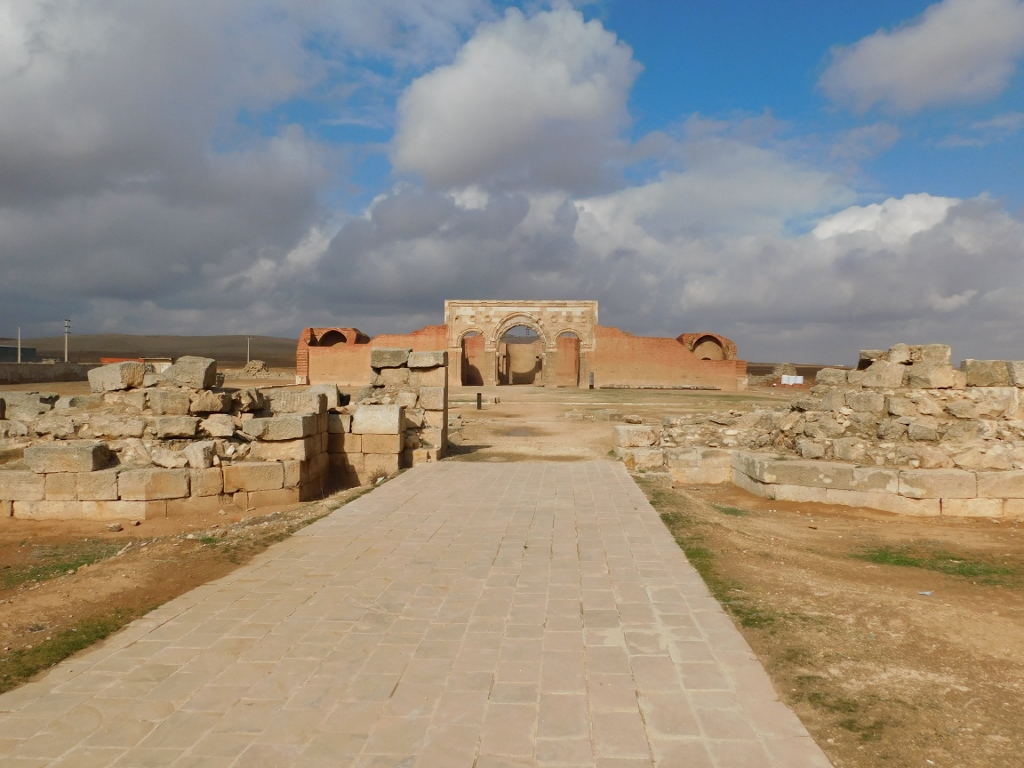 Qasr Al-Mushatta
Qasr Al-Mushatta
Although researchers mention an entrance gateway that would certainly constitute an impressive element, nowadays there is none of that except for the stones that can be seen in the above photo to the left and right from the place where the paved path ends. In fact, even today there are modest remains of the stonework and carved plaster, but at the beginning of the 20th century most of it was given to the German Keiser by the then Ottoman sultan. These remains may be seen today in a Berlin museum.
But, there is still the palace and its front facade that could be seen a little farther away. Although even at the beginning of the site there are some low remains of the walls of the premises that were built around the gateway, I left their sightseeing for later, since I was drawn to the facade of the palace as if it were a magnet.
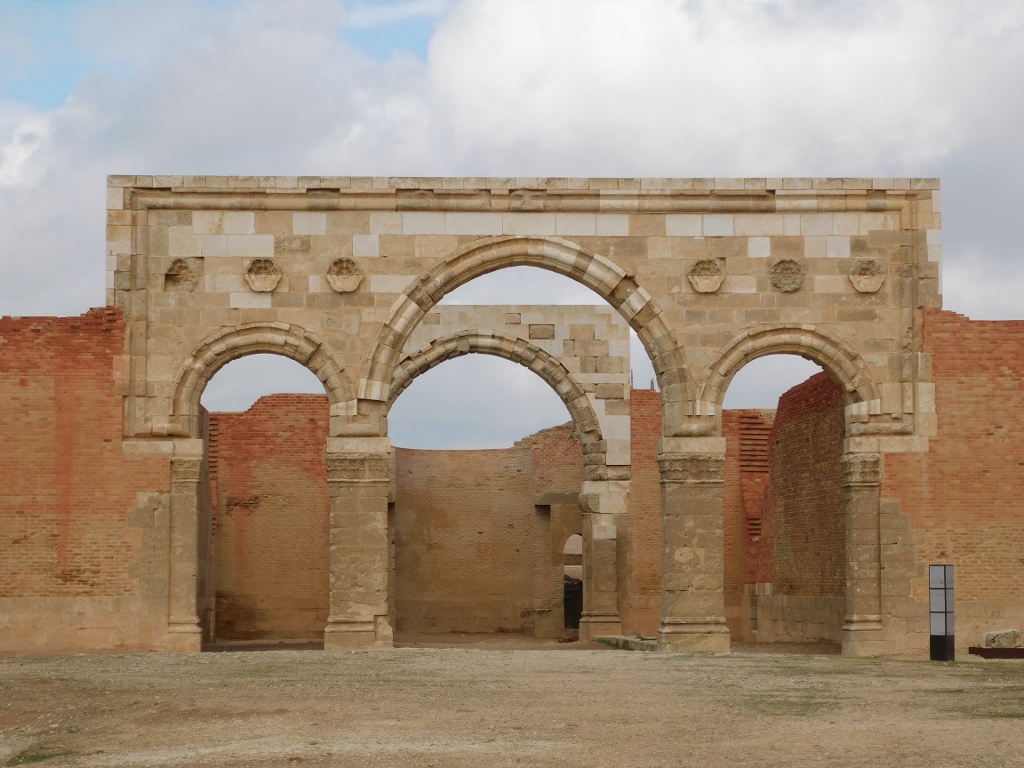 Qasr Al-Mushatta
Qasr Al-Mushatta
As the clouds and the sunlight alternated, so did the colours of the palace’s facade, which will be especially accentuated in some photos I took later, before leaving the site. For the time being I walked slowly towards the palace, while in the courtyard I could see a water pool.
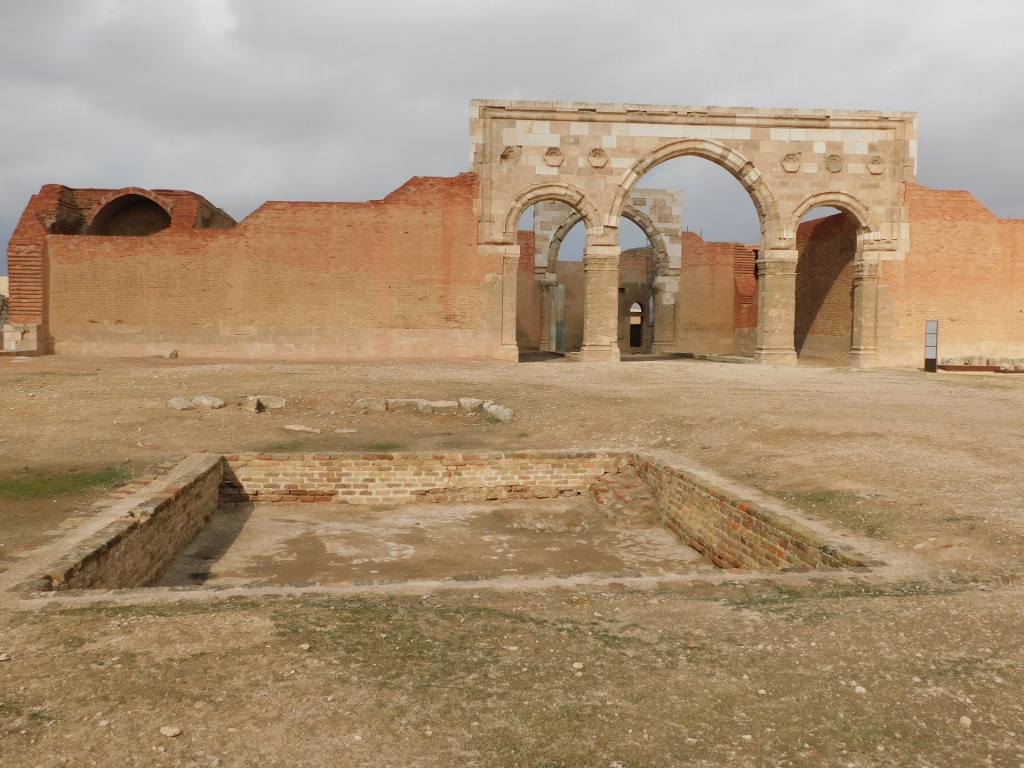 Qasr Al-Mushatta
Qasr Al-Mushatta
The palace’s facade is decorated by a triple arch with very pretty elements.
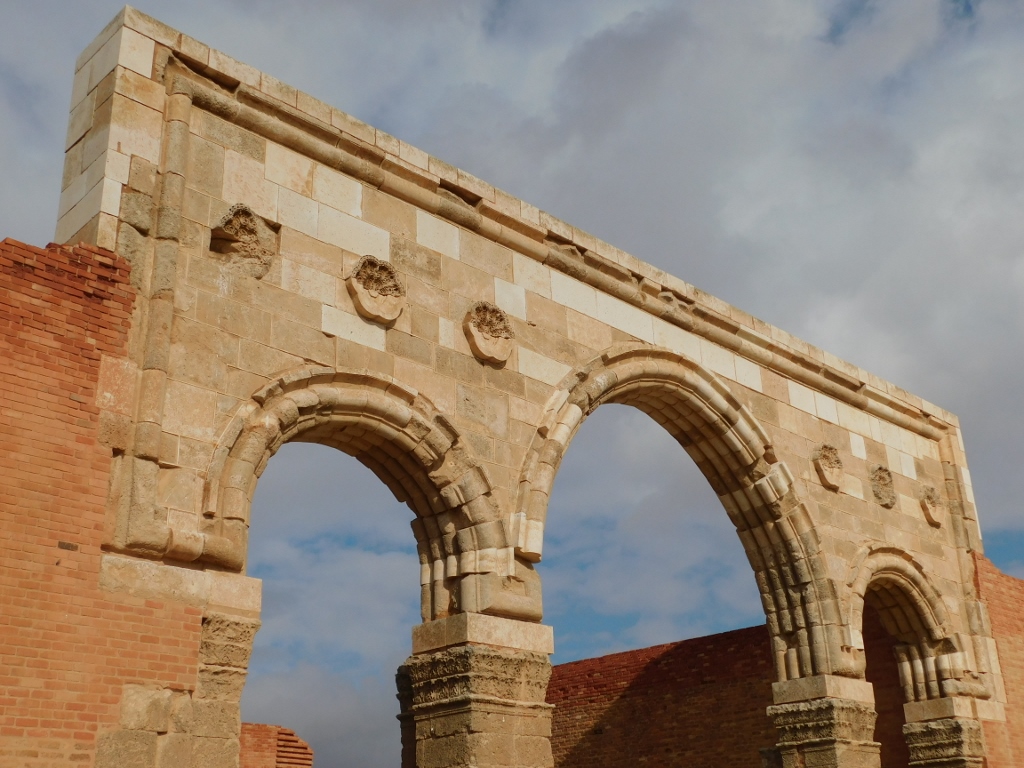 Qasr Al-Mushatta, triple arch on the facade of the palace
Qasr Al-Mushatta, triple arch on the facade of the palace
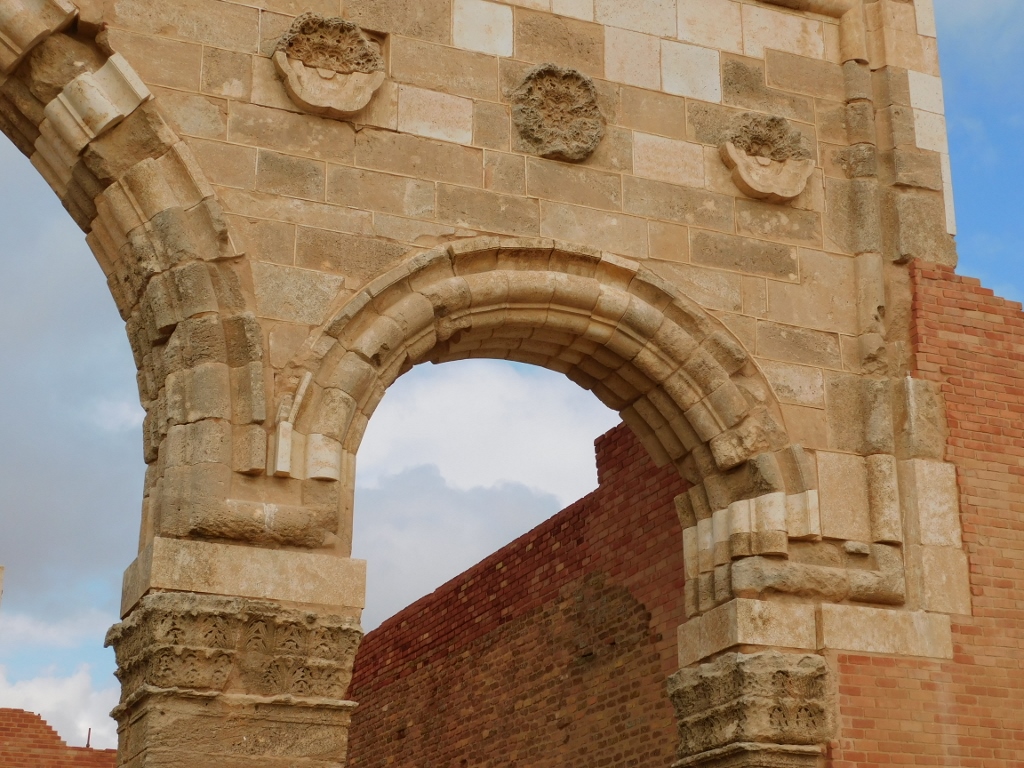 Qasr Al-Mushatta
Qasr Al-Mushatta
When you go through this triple arch, you enter the Columned Hall that is divided by these columns into three aisles. Behind this hall, through the middle arch, one enters directly into the Audience Hall with a semi-circular back. That hall has a trefoil ground plan.
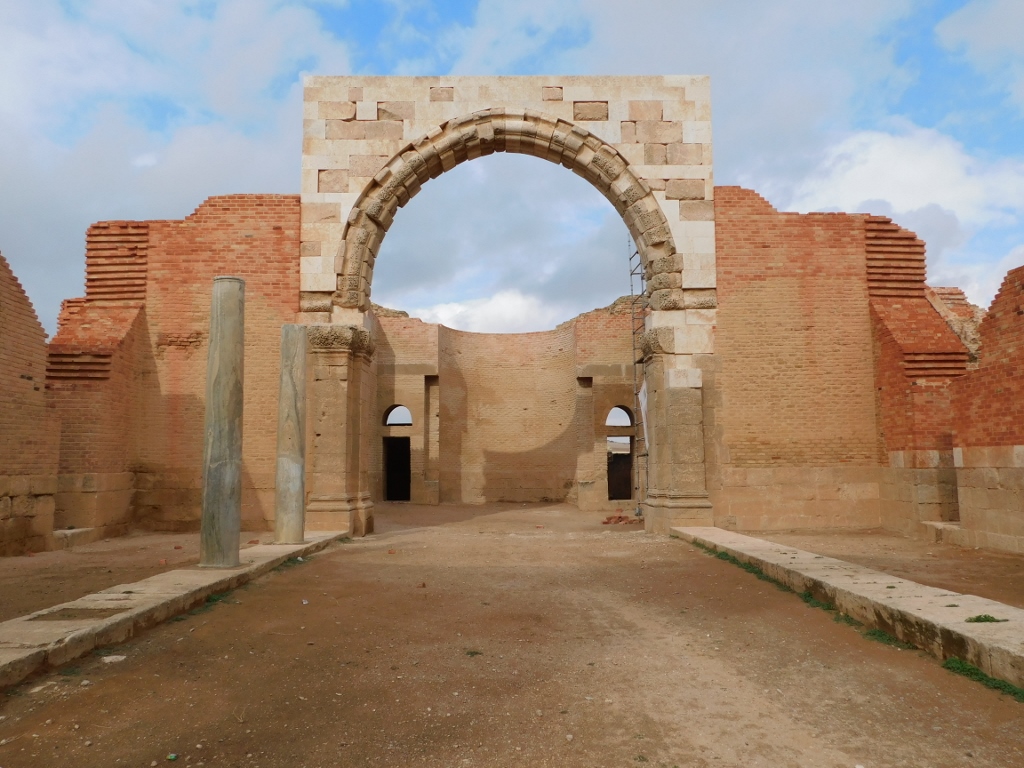 Qasr Al-Mushatta, Columned Hall
Qasr Al-Mushatta, Columned Hall
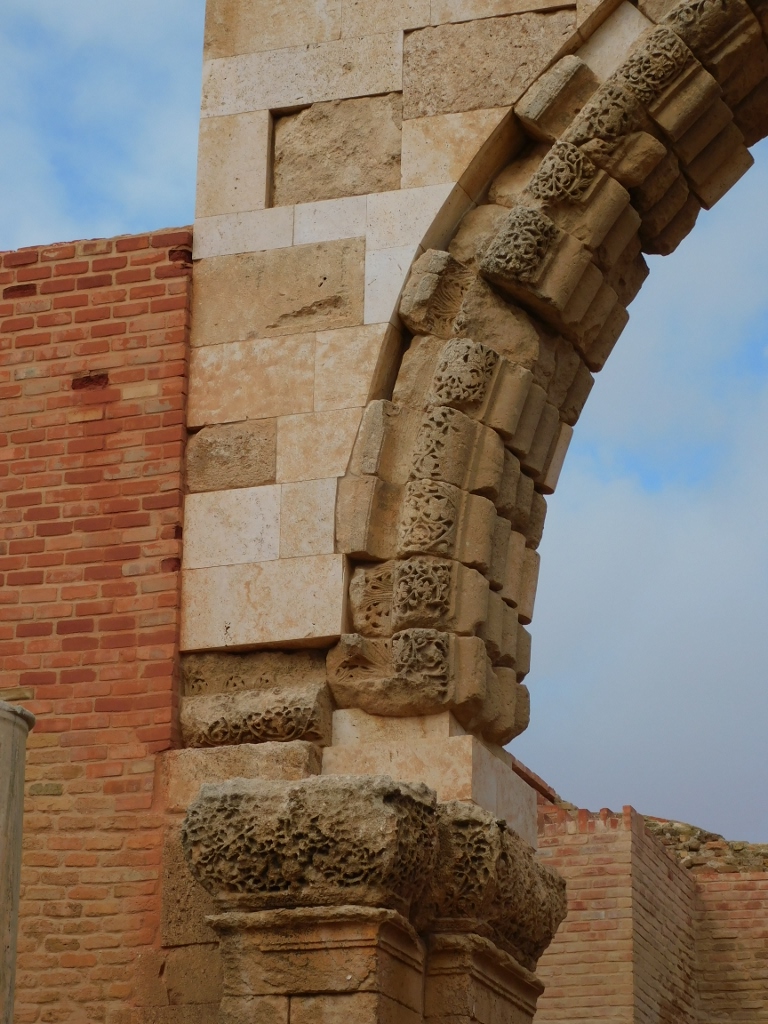 Qasr Al-Mushatta, details of the middle arch
Qasr Al-Mushatta, details of the middle arch
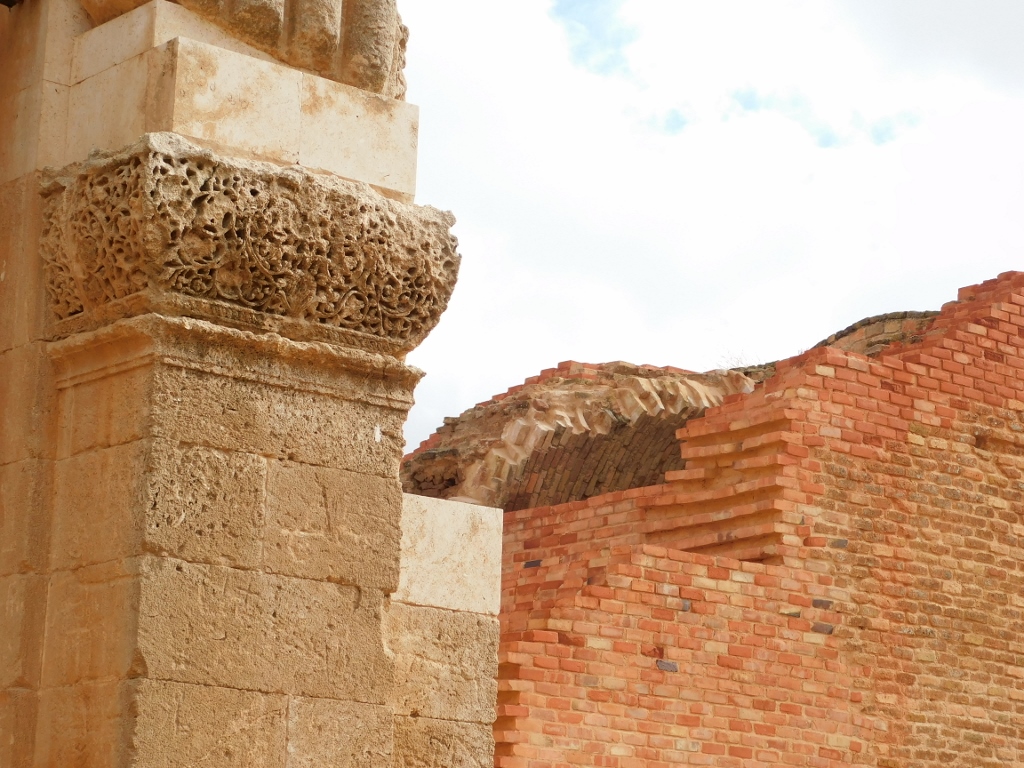 Qasr Al-Mushatta, details of the middle arch
Qasr Al-Mushatta, details of the middle arch
Around the Audience Hall there are symmetrically distributed rooms for the stay of the caliph and his entourage. Also, not only was this “desert castle” never finished, but it was also damaged by an earthquake and so it all just stood like that until the beginning of the 20th century. The restoration and reconstruction started only in the period of 2009-2013. The original parts were reassembled, with the addition of new elements made of the same material using the same technique and only the tools used were the modern ones.
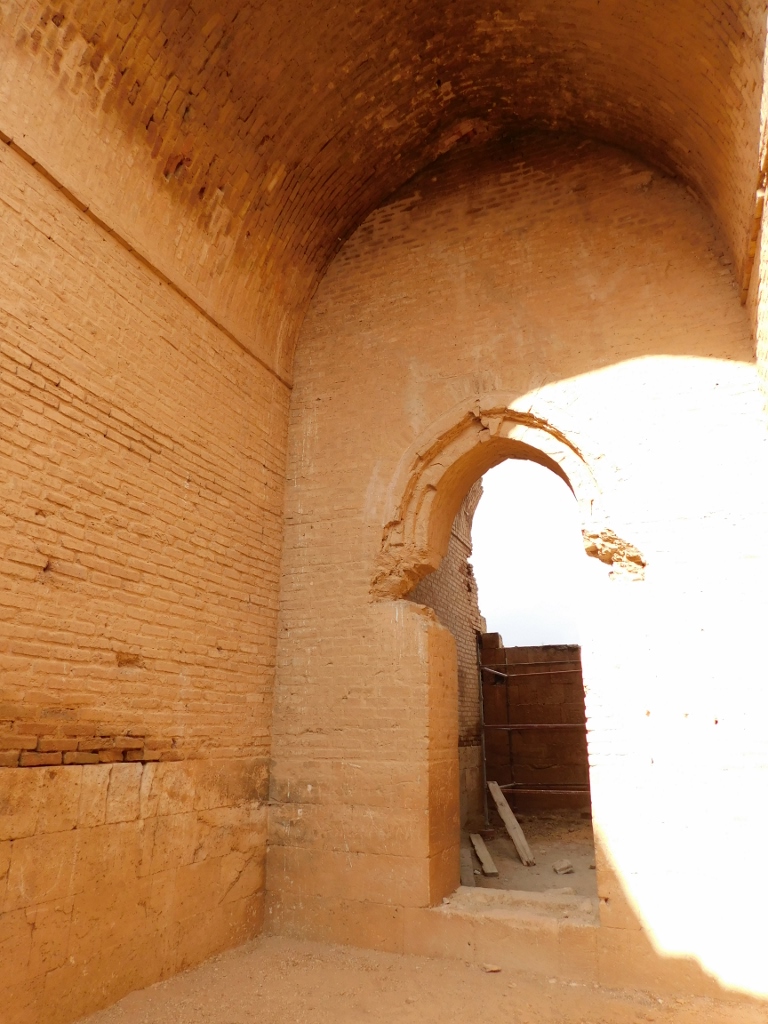 Qasr Al-Mushatta, residential quarters
Qasr Al-Mushatta, residential quarters
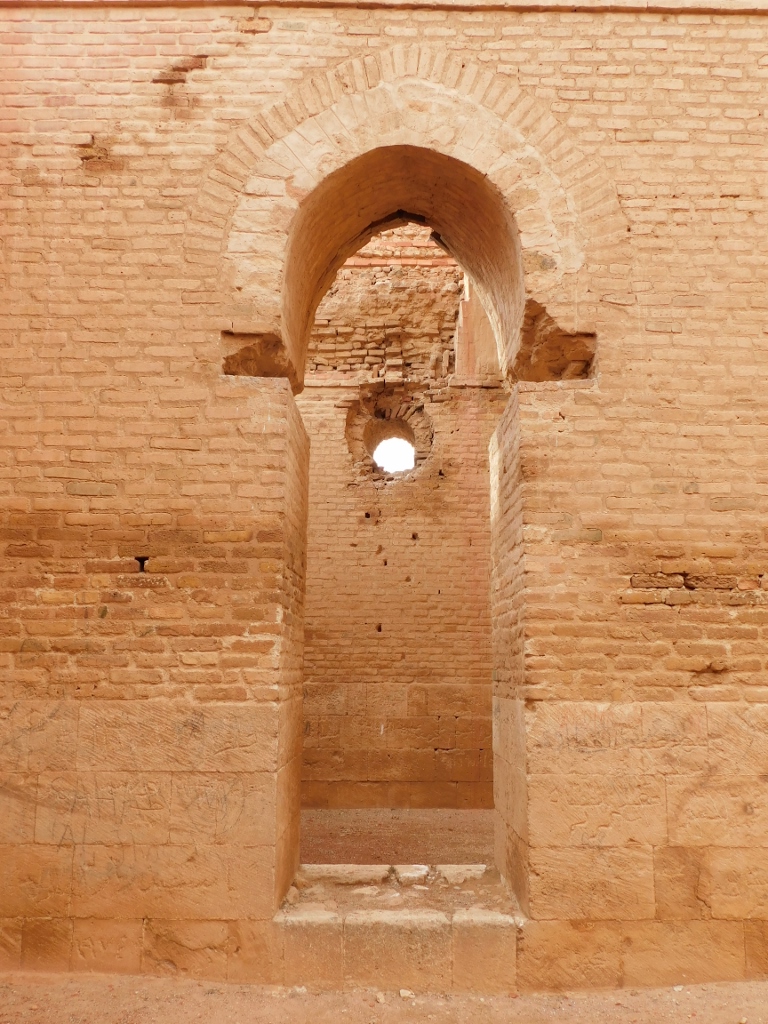 Qasr Al-Mushatta, residential quarters, a detail – the hole in the wall provided the inflow of fresh air
Qasr Al-Mushatta, residential quarters, a detail – the hole in the wall provided the inflow of fresh air
I walked a little more around the remains of the palace within the Qasr Al-Mushatta and so I could observe its sections from different angles.
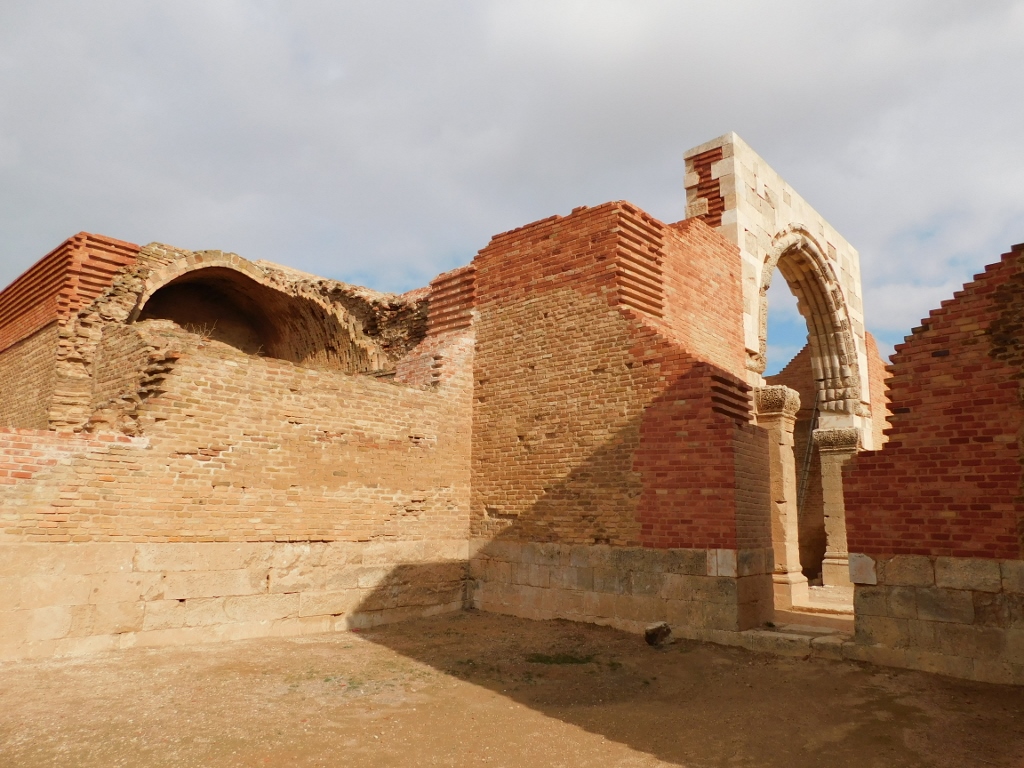 Qasr Al-Mushatta
Qasr Al-Mushatta
And then I left the palace area and went to see the remains of the walls of the premises that used to exist or that were planned to be built, as well as the remains of the enclosure wall.
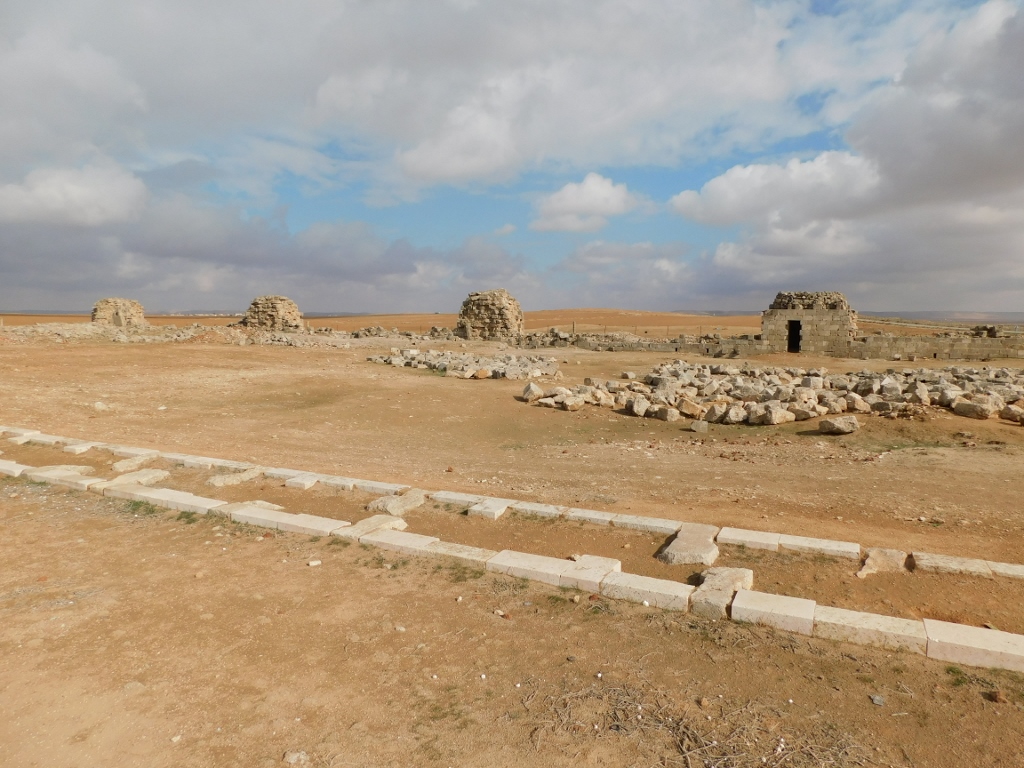 Qasr Al-Mushatta, remains of the old walls
Qasr Al-Mushatta, remains of the old walls
As it may be seen in the photo above, at this point the clouds had dispersed enough to allow the wonderful sunlight to shine on the palace’s facade and that was a truly beautiful image. I took a couple of photographs and then moved on.
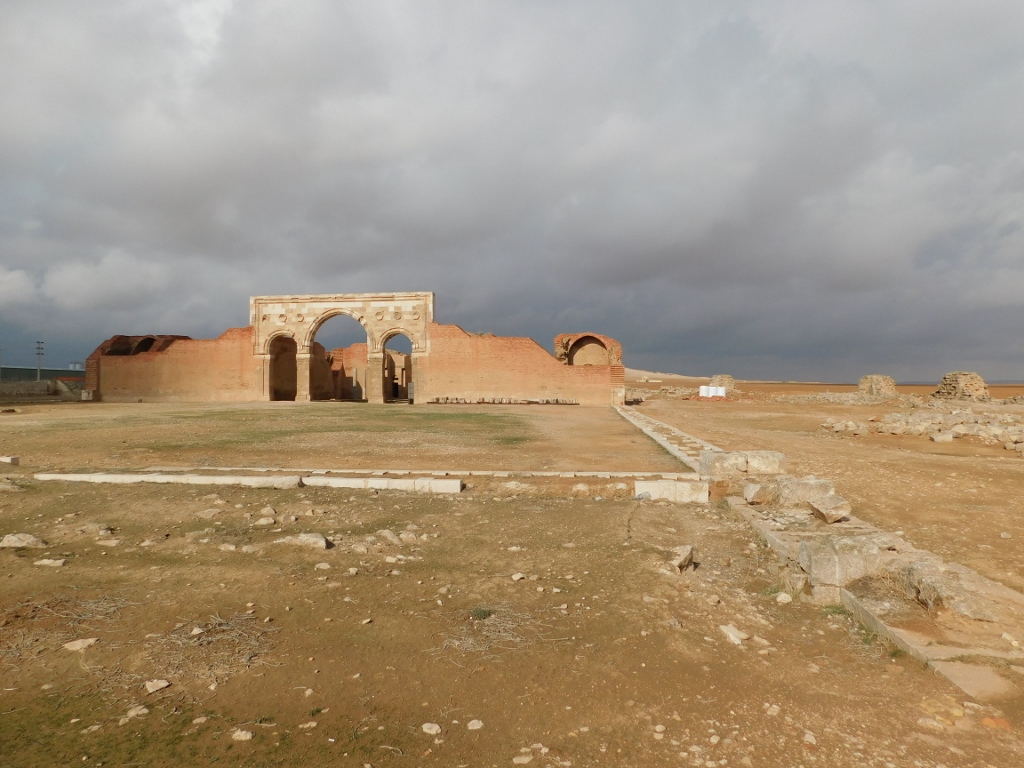 Qasr Al-Mushatta, archaeological site
Qasr Al-Mushatta, archaeological site
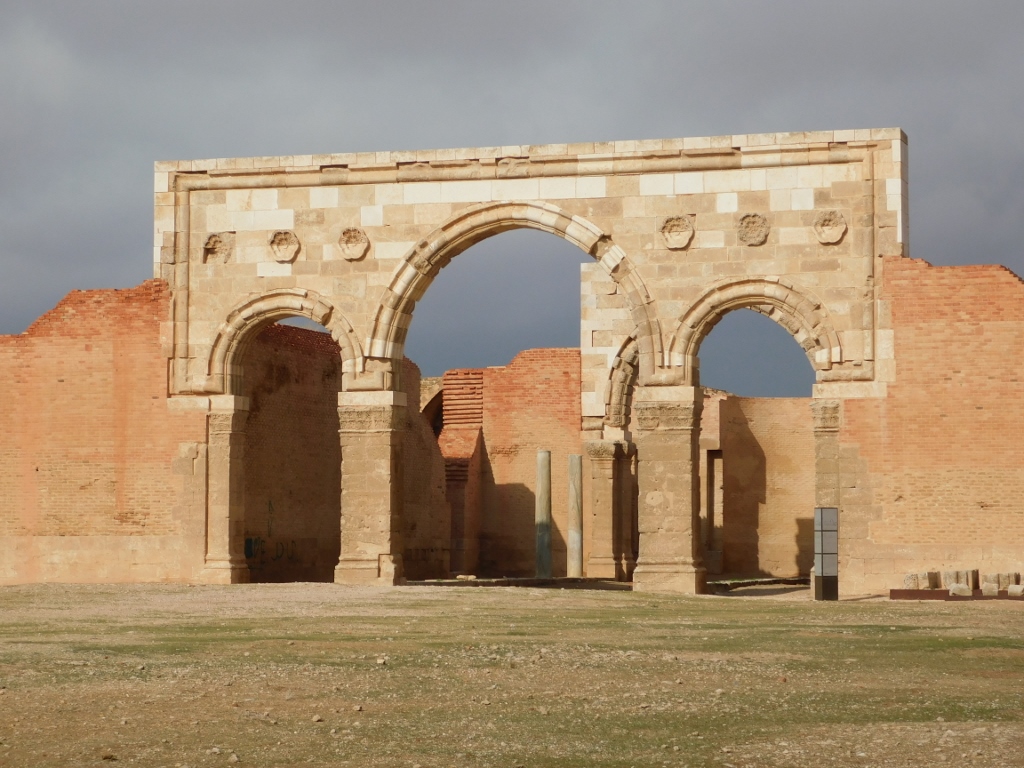 Qasr Al-Mushatta, triple arch at the palace’s facade
Qasr Al-Mushatta, triple arch at the palace’s facade